Don't wanna be here? Send us removal request.
Text
Data Monetization Strategies for Retailers

Written By: Gargi Sarma
Retailers are sitting on a treasure of data in today's data-driven society. Retailers can improve customer experiences, open up new revenue streams, and gain a competitive edge by utilizing this data. Here, we examine several data monetization tactics that merchants might use, backed by actual cases.
For retailers, data is the new gold. They gather a ton of data on demographics, spending patterns, and client behavior. Strategic exploitation of this data can be a goldmine for creating new revenue sources.

Figure 1: Key Data Sources and Monetization Strategies
Market Insights:
Global Data Monetization Market:
The global data monetization market size was valued at USD 2.99 billion in 2023.
It is projected to be worth USD 3.47 billion in 2024 and is expected to reach USD 11.83 billion by 2032.
The market is exhibiting a CAGR of 16.6% during the forecast period.
Retail Component:
The e-commerce and retail segment constitutes approximately 11% of the total data monetization market.
This segment is forecasted to show a compound annual growth rate (CAGR) of 36% from 2016 to 2023.

Figure 2: Regional View of Data Monetization (Source: Technavio)
Emerging Trends:
Private Data Demand: Emerging industries are increasingly demanding private data and analytics, driving the need for data monetization.
Edge Computing: Trends such as Big Data, Artificial Intelligence (AI), and the Internet of Things (IoT) are boosting the demand for edge computing software architecture.
Real-Time Analytics: Chief officials recognize the immense value of real-time data analytics, further fueling the market for private data.
Reasons for Retailers to Profit from Data:
Open up new revenue streams: Data can be sold to suppliers as insights, utilized to create loyalty programs, or targeted advertising.
Improved decision-making: Product placement, inventory control, and targeted marketing efforts can all benefit from data.
Data Monetization Strategies:
Selling Insights to Brands: Retailers have access to valuable information about who purchases what goods, where, and when. When seeking to comprehend market dynamics, brands—especially new ones—need to know this information. When a new product, like laundry baskets, is introduced to the market, a brand may not be aware of who is buying what kinds of laundry baskets, how sensitive they are to price, or how the market is competing. Retailers can profit from these data by helping firms make well-informed choices on new product launches, price policies, and advertising campaigns.
Creating Loyalty Programs: Retailers can create customized loyalty programs by utilizing their data. They are able to provide their consumers with individualized discounts and rewards by examining their purchasing habits and preferences. This improves consumer satisfaction and retention while offering an additional avenue for data collecting, hence expanding the retailer's database.
Target Advertising: Retailers can use their data to provide companies with extremely focused advertising options. Retailers may better assist companies in reaching their target audience by helping them understand customer demographics and purchase behaviors. To boost conversion rates, a new skincare company might, for example, aim advertisements just at consumers who have already bought skin care goods.
Optimizing Product Placement and Inventory Control: Retailers can improve inventory control and product positioning with the aid of data analytics. Retailers may cut waste and boost sales by stocking the correct products in the right locations by knowing which products are popular in certain areas. Additionally, this data-driven strategy aids in more effective inventory management and demand prediction.
Conclusion:
Retailers today have access to a wealth of data that might significantly boost consumer happiness and revenue development. Retailers may enhance their competitiveness in the market, generate new revenue streams, and streamline operations by strategically exploiting this data. Retailers can take advantage of digital marketplaces, branch out into e-commerce, or even form strategic alliances by utilizing their comprehensive consumer data in addition to conventional brick-and-mortar techniques. In addition to being in line with current economic trends, this proactive strategy sets up merchants for success in the digital age.
Retailers may efficiently use their data to make choices, automate pricing tactics, and improve overall business performance by utilizing advanced analytics and pricing solutions such as those provided by RapidPricer. Find out how RapidPricer can turn your data into a valuable asset that promotes client loyalty and long-term growth.
Read more on Leveraging Wearables for Smart Retail Pricing and Promotion
About RapidPricer
RapidPricer helps automate pricing and promotions for retailers. The company has capabilities in retail pricing, artificial intelligence, and deep learning to compute merchandising actions for real-time execution in a retail environment.
Contact info:
Website: https://www.rapidpricer.com/
LinkedIn: https://www.linkedin.com/company/rapidpricer/
Email: [email protected]
#retaildata hashtag#datamonetization hashtag#customerexperience hashtag#retailinnovation hashtag#aiinretail hashtag#datadriveninsights
0 notes
Text
Automating Flash Sales and Markdown Events

Written By: Gargi Sarma
In the dynamic world of retail, staying competitive requires flexibility, data-driven decision-making and efficient operations. Flash sales and discounts play a crucial role in increasing sales, managing inventory and attracting customers. However, the traditional manual approach to pricing can be time-consuming, error-prone and expensive. In this article, we'll explore the benefits of flash sales and discount automation, explore the amazing impact of unsold products, and highlight how retailers can use automation to optimize their processes.

Figure 1: Problems in Retail Sector
The Price of Unsold Goods
Food Waste in Retail
Let's begin with an unexpected analogy: food waste. Fashion and retail establishments struggle with enormous amounts of unsold stuff, much as perishable food items might go unsold and end up wasted. These are a few startling statistics:
Food Waste
Every year, between 30% and 40% of the food supply in the US is wasted.
Over 3 million tons of discarded clothing are in landfills, while over 700,000 tons are shipped abroad.
Almost 6 million tons of unsold food, comprising both edible goods and inedible waste, are produced by the grocery retail industry.
Fashion Industry
Approximately 21 million clothing items (6.5% of Dutch retail stocks) are never sold, and only 33% are subsequently sold following markdowns or reductions.
The garment industry's excess of returned and unsold inventory is estimated to be worth about 700 billion euros.
The Label Changes and Labor Costs
When it comes to labor-intensive manual activities like label change for markdowns and promotions, retailers must bear heavy labor expenditures. Let's dissect it:
Label Changes:
When there are sales and markdowns, retail staff members manually alter price labels for hours on end.
These labor-intensive chores take up resources that may be used for more strategic endeavors.
Cost Implications:
Profitability is directly impacted by the cost of store labor for label updates.
Labor costs mount up, particularly when multiplied by a number of locations and frequent price changes.
These demonstrate how desperately retail operations need to become more efficient. One innovative way to tackle these issues head-on is to automate markdown and flash sale events.
Market Insights:
The retail sector is embracing automation, and flash sales and markdown events are prime targets for this innovation. Let's dive into some statistics that highlight the potential:
Flash Sale Growth: A study by WP Pluginsify found a 35% surge in transaction rates during flash sales [Source: WP Pluginsify]. This signifies the power of these events to drive immediate purchases.
Time-Sensitive Appeal: According to Lark Suite, 50% of all purchases within a flash sale occur in the first hour [Source: Lark Suite]. Automation ensures you capitalize on this critical window by triggering sales at the optimal time.
Inventory Clearance: Flash sales are a powerful tool for inventory management. A study by Shopify found that companies that leverage flash sales experience a 63% reduction in excess inventory [Source: Shopify blog post (title: How Flash Sales Can Boost Your Inventory Management Strategy)].
Automation Efficiency: Marketing automation can generate a 451% increase in qualified leads [Source: Marketo]. Applying this to flash sales translates to more targeted promotions reaching the right customers, maximizing the impact.
Dynamic Pricing Impact: A study by McKinsey revealed that companies that adopted dynamic pricing strategies saw an average revenue uplift of 1.1% to 4.2% [Source: McKinsey & Company report (title: Price elasticity and the future of pricing)]. Automation allows retailers to adjust prices for flash sales based on real-time market data, maximizing profit margins.

Figure 2: Impact of Automation on Key Retail Metrics
How Automation Addresses These Issues
Data-Driven Decision Making: Automated systems use real-time data and sophisticated algorithms to decide when and how much to markdown. This strategy increases profitability while reducing uncertainty.
Dynamic Pricing Models: Automation makes it possible for dynamic pricing models, which modify prices in response to variables such as rival pricing, demand trends, and inventory levels. This adaptability guarantees that costs stay reasonable and appealing to consumers.
Streamlined Operations: A smooth process for handling markdowns and promotions can be achieved by integrating automation solutions with current retail management systems. This integration improves operating efficiency and lowers the possibility of human error.
Real-Time Monitoring and Adjustments: Retailers have the ability to track sales success in real-time and quickly alter their pricing strategy in response to changing circumstances. This kind of dexterity is essential in high-stakes situations like flash sales.
Retailers Leading the Way
A number of retailers have effectively instituted automated systems to oversee their markdown and flash sales events.
Walmart: Walmart optimizes its pricing methods, cutting down on food waste and raising overall profitability with the use of cutting-edge AI and machine learning algorithms.

Zara: The fast-fashion behemoth uses technology to oversee sales and markdowns, guaranteeing quick inventory turnover and less excess.

Tesco: Tesco's automated technologies improve stock management and drastically reduce food waste by dynamically adjusting prices based on expiration dates.

Amazon: The massive online retailer has expanded its global merchant base by thousands while utilizing technology to control inventory and expedite sales.

Benefits of Automating Markdown and Flash Sales:
Enhanced Efficiency: Planning and carrying out sales events takes less time and effort when automation is used.
Increased Accuracy: Data-driven judgments made by automated systems lower the possibility of human error.
Increased Profit Margins: Pricing tactics that are optimized maximize sales while reducing markdown losses.
Improved Customer Insights: More sophisticated analytics offer more in-depth understanding of consumer behavior, paving the way for more successful sales tactics.
Future of Retail:
Automation is about establishing a competitive edge, not just about efficiency. Retailers can develop dynamic pricing strategies that maximize revenues, clear inventory, and create engaging customer experiences by utilizing automation and market data. Flash discounts and markdowns turn from being reactive to strategic strategies that propel success and growth in the dynamic retail environment.
Conclusion:
The retail price optimization industry is being revolutionized by automating markdowns and flash sales. Retailers may carry out these events more profitably, precisely, and efficiently by utilizing AI, predictive analytics, and dynamic pricing engines. The implementation of automation technology not only increases operational efficiency but also boosts customer happiness and sales, as demonstrated by companies such as Amazon and Zara.
Retailers should think about implementing automated solutions for their markdown and flash sales events if they want to remain competitive in the fast-paced market. RapidPricer offers a comprehensive solution for automating these critical sales strategies. With its powerful analytics and AI-driven capabilities, RapidPricer empowers retailers to execute flawless flash sales and markdown events, ensuring optimal pricing and inventory management. Embrace the future of retail with RapidPricer and transform your sales events into powerful revenue drivers.
Read more on Enhancing Customer Loyalty with AI-Driven Pricing and Rewards
About RapidPricer
RapidPricer helps automate pricing and promotions for retailers. The company has capabilities in retail pricing, artificial intelligence, and deep learning to compute merchandising actions for real-time execution in a retail environment.
Contact info:
Website: https://www.rapidpricer.com/
LinkedIn: https://www.linkedin.com/company/rapidpricer/
Email: [email protected]
0 notes
Text
Robots in the Retail Aisle: Automating Retail Store Management, eCommerce, and Customer Service

Written By: Gargi Sarma

Figure 1: Global Market Size of the Artificial Intelligence (AI) Robot Market from 2020 to 2030
Retail Robotics Market Size and Growth:
The retail robotics market has been rapidly expanding. In 2020, the market size was valued at $7.60 billion. However, projections indicate that it will exceed $69 billion by 2028, growing at an impressive CAGR of 31.61% between 2021 and 2028 (Source: Rinf.tech).
Inventory management accounted for the largest market share in 2020 (33.16%), with a market value of $2.5 million. It is projected to grow at the highest CAGR of 37.06% between 2021 and 2028 (Source: Rinf.tech).
In 2021, the global delivery robots market was worth approximately $212 million. By 2027, it is expected to reach just under $1 billion (Source: Statista).
Transforming Retail Store Management
Inventory Management
One of the most significant contributions of robots in retail store management is in inventory management. Traditional methods of stock-taking are labor-intensive and prone to human error. Robots equipped with advanced sensors and artificial intelligence can autonomously navigate store aisles, scanning shelves to monitor stock levels, identify misplaced items, and track expiration dates. This real-time data allows retailers to optimize inventory, reduce wastage, and ensure shelves are always stocked, enhancing overall efficiency.
Pricing and Promotion
Robots are revolutionizing pricing and promotion strategies by providing real-time data analytics and automation. These robots can monitor inventory levels, competitor pricing, and consumer behavior to dynamically adjust prices and promotions, ensuring optimal profitability and competitiveness. By automating these processes, retailers can implement precise pricing strategies and personalized promotions, enhancing customer satisfaction and driving sales.
Store Maintenance

Figure 2:��Retail Store Management - (a) Walmart’s Bossa Nova, (b) Stop & Shop’s Marty, (c) Simbe Tally Robot and (d) Amazon Go
Examples:
Walmart: Deploys Bossa Nova robots to scan shelves and check stock levels, prices, and misplaced items. These robots move up and down the aisles, using cameras and sensors to capture data and send it to store employees for restocking and organizing.
Stop & Shop: Uses a robot named Marty to roam the aisles, scanning for spills, debris, and other hazards. Marty also helps with inventory checks.
Amazon Go: Stores utilize a "Just Walk Out" technology where customers can pick items and leave the store without stopping at a checkout counter. Cameras, sensors, and computer vision track what items customers take, and their Amazon accounts are automatically charged.
Simbe Robotics: Their Tally robot autonomously roams store aisles to audit shelves for out-of-stock items, pricing errors, and product misplacements. This helps ensure shelves are well-stocked and organized, improving store efficiency.

Figure 3: E-commerce Operations - (a) Ocado’s pick and pack groceries robots, (b) Alibaba’s automated guided vehicles, (c) Starship Technologies’s delivery robots, (d) Amazon Scout
Order Fulfillment
In the eCommerce sector, robots are streamlining order fulfillment processes. Warehouses and distribution centers increasingly deploy automated systems to pick, pack, and ship products. These robots can work around the clock, increasing throughput and reducing the likelihood of errors. Technologies like Amazon's Kiva robots exemplify how automation can transform logistics, leading to faster delivery times and improved customer satisfaction.
Last-Mile Delivery
The last mile of delivery—the final step of getting products to consumers—has always been a logistical challenge. Autonomous delivery robots and drones are emerging solutions to this problem. Companies like Starship Technologies and Wing are pioneering robotic delivery services, promising faster, more reliable, and cost-effective delivery options. This innovation not only enhances customer experience but also reduces traffic congestion and carbon emissions.
Examples:
Ocado: A UK-based online grocery retailer, utilizes highly automated warehouses where robots pick and pack groceries. Their robotic system can manage thousands of orders simultaneously, increasing efficiency and reducing errors.
Alibaba: In their "smart warehouses," robots called AGVs (Automated Guided Vehicles) transport goods around the warehouse, significantly speeding up the picking and packing process.
Starship Technologies: Offers autonomous delivery robots that can navigate sidewalks to deliver packages and groceries to customers. Retailers like Tesco and Coop in the UK have used Starship robots for last-mile delivery.
Amazon Scout: An autonomous delivery device designed to safely get packages to customers using pedestrian sidewalks.

Figure 4: Customer Service - (a) SoftBank Robotics' Pepper, (b) McDonals’s self-service kiosks, (c) LoweBot
In-Store Assistance
Robots are becoming valuable assistants on the retail floor. Service robots, such as SoftBank's Pepper, are designed to interact with customers, providing information, answering questions, and even processing transactions. These robots use natural language processing and machine learning to understand and respond to customer inquiries, offering a personalized shopping experience. They can also guide customers to specific products, recommend items, and provide entertainment, creating a unique and engaging shopping atmosphere.
Virtual Customer Service
Online retail is also benefitting from robotic customer service. Chatbots and virtual assistants powered by AI handle a significant portion of customer interactions on eCommerce platforms. These digital agents can manage inquiries, process returns, and offer personalized recommendations based on customer data. By providing 24/7 support, they enhance customer satisfaction and loyalty while reducing the workload on human customer service teams.
Examples:
SoftBank Robotics' Pepper: Deployed in stores like Sephora, Pepper greets customers, answers questions, and provides product information. It can engage customers through conversation and help them find what they're looking for.
Lowe's: Uses a robot named LoweBot to help customers find products within the store. LoweBot can understand and respond to voice inquiries, guide customers to the right aisles, and provide information about product availability.
H&M: Implements chatbot assistants on their website and app to help customers with product inquiries, order tracking, and personalized recommendations.
Nordstrom: Uses a virtual stylist service where AI-powered chatbots and human stylists work together to provide fashion advice and personalized shopping experiences to online customers.
McDonald's: Introduced self-service kiosks in many locations, allowing customers to place orders and make payments without interacting with a cashier. These kiosks can also upsell by suggesting additional items based on the customer's order.

Figure 5: Projected Impact of Automation by Core Merchandising activity (Source: McKinsey & Company)
Benefits
Efficiency and Accuracy: Robots perform repetitive tasks with high precision, reducing errors and increasing operational efficiency.
Cost Savings: Automation can lead to significant labor cost reductions and lower operational expenses.
Enhanced Customer Experience: Robots can provide faster, more accurate service, enhancing the overall customer experience.
Data Collection: Robots can gather vast amounts of data, providing valuable insights into customer behavior and operational efficiency.
Challenges
Initial Investment: The cost of implementing robotic systems can be high, posing a barrier for smaller retailers.
Technical Issues: Robots can face technical glitches and malfunctions, potentially disrupting operations.
Job Displacement: The rise of automation raises concerns about job displacement for workers performing routine tasks.
Customer Acceptance: Some customers may be hesitant to interact with robots, preferring human interaction.
The Future of Robots in Retail
As technology continues to advance, the role of robots in retail is set to expand. Innovations in AI, machine learning, and robotics will drive further enhancements in efficiency and customer service. Future developments may include more sophisticated in-store robots capable of performing complex tasks, fully autonomous delivery systems, and even greater integration of AI in customer interactions.
Retailers must strike a balance between leveraging automation to improve operations and maintaining a human touch to meet customer expectations. By doing so, they can create a seamless and enjoyable shopping experience that combines the best of both worlds.
In conclusion, robots are transforming the retail industry by automating store management, enhancing eCommerce operations, and revolutionizing customer service. While challenges remain, the benefits of incorporating robots into retail strategies are compelling. As technology evolves, the retail sector will continue to innovate, offering new opportunities for growth and improvement.
RapidPricer offers an innovative solution for retail automation. Their platform leverages artificial intelligence (AI) and deep learning to automate pricing and promotions in real time within a retail environment. Read More on AI-Driven Automated Consumption in Retail.
About RapidPricer
RapidPricer helps automate pricing and promotions for retailers. The company has capabilities in retail pricing, artificial intelligence, and deep learning to compute merchandising actions for real-time execution in a retail environment.
Contact info:
Website: https://www.rapidpricer.com/
LinkedIn: https://www.linkedin.com/company/rapidpricer/
Email: [email protected]
0 notes
Text
Retail & The Future of Work: How Technology Will Reshape Retail Jobs

Written By: Gargi Sarma

Figure 1: Expected Retail Technology Growth (2022) Automation and Efficiency: The integration of automation in retail pricing and promotions is another key trend reshaping the workforce. Automated systems can manage large volumes of pricing data, execute price changes across multiple platforms instantaneously, and ensure consistency in promotional messaging. This reduces the need for manual intervention, allowing retail employees to focus on more strategic tasks, such as analyzing campaign performance and refining marketing strategies.

Figure 2: Innovation in the Retail Robotics Industry Workforce Implications:
As technology continues to drive change in retail, the workforce will need to adapt. Employees will require new skills to manage and leverage advanced technologies effectively. Training programs focused on data analysis, AI, and digital marketing will become essential. Retail roles will evolve, with a greater emphasis on strategic decision-making, creativity, and customer relationship management.


Figure 4: Generative AI will Transform Work Across Industries (Worldwide) - 2022
Dynamic Pricing and AI:
One of the most revolutionary technologies in retail is dynamic pricing, powered by artificial intelligence (AI) and machine learning algorithms. Unlike traditional pricing methods, which rely on periodic adjustments based on market trends and competitor analysis, dynamic pricing allows retailers to adjust prices in real-time based on a myriad of factors. These factors include supply and demand fluctuations, competitor pricing, customer browsing behavior, and even weather conditions.
For instance, AI can analyze historical sales data and predict future demand with high accuracy. This enables retailers to optimize their pricing strategies dynamically, ensuring that prices are always set at the optimal level to maximize revenue and profit. Moreover, AI-driven pricing models can help retailers identify the best times to run promotions, tailor discounts to individual customers, and even segment customers based on their price sensitivity.
Personalized Promotions:
Technology is also transforming how retailers approach promotions. With the rise of big data analytics, retailers now have unprecedented insights into customer behavior and preferences. This data allows for highly personalized promotional strategies that can significantly increase conversion rates and customer loyalty.

Figure 5: Grocery Executives See Potential Gen AI "Killer Applications" in Both the Front and Back Office (2023) Examples:
Walmart employs autonomous floor scrubbers and shelf-scanning robots to handle repetitive tasks, freeing up employees to focus on customer service and complex problem-solving.
Amazon uses AI to predict inventory needs and manage stock levels efficiently. This reduces the workload on employees, allowing them to focus on fulfillment and customer support.
IKEA’s AR app allows customers to visualize furniture in their homes before purchase, reducing the need for in-store consultations and empowering employees to assist with more personalized design advice.
Amazon Go stores use sensors and cameras to track items customers take, eliminating the need for traditional cashier roles. Employees can then be redeployed to enhance customer experience and store management.
Target uses data analytics to optimize product placements and marketing strategies, which helps employees make informed decisions about inventory management and customer interactions.
Walmart integrates its e-commerce platform with physical stores, enabling employees to manage online orders, in-store pickups, and deliveries efficiently.
Tesco equips employees with wearable devices to streamline communication and task management, improving efficiency and responsiveness on the sales floor.
Sephora uses CRM to track customer preferences and purchase history, enabling employees to provide personalized recommendations and enhance the shopping experience.
Lowe’s uses IoT sensors to monitor stock levels and environmental conditions, ensuring timely restocking and reducing the manual workload on employees.
Apple Store employees use mPOS devices to assist customers anywhere in the store, speeding up transactions and improving customer satisfaction.

Figure 6: Frontline Retail Worker’s Opinion on by percentage technology will create new job opportunities by subsector
Conclusion
The future of retail is undeniably intertwined with technological advancement. As pricing and promotion strategies become more sophisticated and data-driven, retailers who embrace these changes will be better positioned to thrive in a competitive market. The workforce, too, will evolve, with new opportunities arising from the integration of technology. By focusing on continuous learning and adaptability, retail employees can ensure they remain valuable contributors in this dynamic industry. Ultimately, technology will not only reshape retail jobs but will also enhance the overall shopping experience for consumers, creating a win-win scenario for all stakeholders.
RapidPricer, a dynamic pricing and inventory optimization platform, leverages AI and machine learning to adjust prices in real-time based on market demand and competition. By automating these processes, RapidPricer helps retailers enhance profitability, reduce manual pricing tasks, and optimize stock levels, thereby allowing employees to focus on more strategic activities such as customer engagement and personalized service.
Read More on Build Pricing Capabilities Inside Your Organization
About RapidPricer
RapidPricer helps automate pricing and promotions for retailers. The company has capabilities in retail pricing, artificial intelligence, and deep learning to compute merchandising actions for real-time execution in a retail environment.
Contact info:
Website: https://www.rapidpricer.com/
LinkedIn: https://www.linkedin.com/company/rapidpricer/
Email: [email protected]
0 notes
Text
Leveraging Wearables for Smart Retail Pricing and Promotion

Written By: Gargi Sarma

Figure 1: The Global Wearables Market Is All About the Wrist
According to International Data Corporation (IDC), wrist-worn fitness trackers and smartwatches have been the main drivers of the wearable market's expansion. It is projected that 95% of wearables shipped this year will consist of these devices, and they will continue to dominate the industry until 2022.
Market Growth: According to Mordor Intelligence, the smart wearable industry is expected to reach USD 205.10 billion by 2029, growing at a compound annual growth rate (CAGR) of 19.48% from its estimated USD 84.23 billion in 2024. This indicates that consumer adoption has increased significantly.
Personalized Promotions Based on Health Data:
Retailers are using wearable device data more and more to create customized promotions. For example, companies like Nike and Lululemon are using data from wearable technologies into their consumer loyalty programs. These businesses are able to provide customers with personalized offers and product recommendations by evaluating biometric data. To increase the chance of a purchase, a merchant may give discounts on sportswear or running shoes if a wearable gadget, for instance, shows a high degree of physical activity.
Under Armour is a prime example, having created the "UA Record" platform. This software tracks exercise, sleep, and nutrition by syncing with many wearables. Through the utilization of this information, Under Armour is able to provide users with individualized training gear and nutritional items, along with deals and promotions that are in line with their activity levels and health objectives.
Dynamic Pricing Strategies:
Another cutting-edge strategy in the retail industry is the incorporation of biometric data from wearables into dynamic pricing plans. Real-time price adjustments are made via dynamic pricing, which takes into account a number of variables such as customer information, inventory levels, and demand. This technique gains additional depth from wearable devices, which offer real-time activity and health data.

Figure 2: Number of Connected Wearable Devices, Globally by Region, 2021 - 2022
Enhanced Customer Engagement and Loyalty:
Enhancing customer engagement and loyalty is another important function of wearable technology. Retailers can make shopping experiences more dynamic and interesting by utilizing biometric data. For instance, based on a user's stress level or sleep habits, which have an impact on skin health, Sephora's Beauty Insider loyalty program might use data from wearable technology to provide customized beauty advice and product recommendations.
Additionally, the purchasing experience can be made more engaging by using wearable data. Retailers can set challenges and provide prizes to clients who achieve their fitness and health objectives. Adidas , for example, has tested incorporating wearable data into its Runtastic app to motivate users to take part in fitness contests. Rewarding themselves with special product offers or discounts, successful participants develop a stronger bond with the company.
Walmarts Health and Wellness Initiatives:
One of the biggest retailers in the world, Walmart, has led the way in incorporating wearable technology into its business strategy. Walmart and Sharecare, a digital health startup, teamed in 2020 to give workers devices that track various health parameters. Although Walmart analyzes aggregated data to understand overall employee wellness trends, the data obtained also helps employees better manage their health.
This program benefits the workforce in two ways: it makes employees healthier and gives Walmart useful information about health trends that company can use to inform product offerings and marketing campaigns. Walmart may better serve its wider customer base by customizing its health and wellness product lines based on an awareness of the biometric data trends of its employees.
Example:
As they improve consumer experiences and operational efficiency, smart wearables are in fact changing the retail sector. Examples of how wearables affect promotion and pricing are as follows:
Contactless Payments via Smartwatches:
Smartwatches enable seamless contactless payments, bypassing the need for physical wallets or smartphones.
Shoppers can make purchases directly from their wrists, enhancing convenience during in-store transactions.

Figure 3: Fitbit 4 Smartwatch
The Fitbit Versa 4 is a small, light fitness tracker that allows for instantaneous contactless payments and displays workout data.
Personalized Marketing and Coupons:
Wearables collect data on user behavior, location, and preferences.
Retailers can use this information to push personalized marketing messages, targeted coupons, and special offers to potential customers as they approach stores.
This data-driven approach increases foot traffic and drives sales.
In-Store Navigation and Assistance:
Smart glasses or AR-enabled wearables can guide shoppers within stores.
Real-time navigation, product recommendations, and promotional alerts enhance the overall shopping experience.
Employee Efficiency and Inventory Management:
Wearables equipped with RFID technology help employees track inventory levels, restock shelves, and manage stockouts.
Real-time data ensures accurate pricing, reduces errors, and optimizes inventory.
Health Monitoring for Staff and Customers:
Wearables can monitor employee health (e.g., fatigue levels, stress) to optimize staffing and ensure well-being.
For customers, health-tracking features can enhance personalized recommendations (e.g., suggesting energy-boosting snacks after detecting low activity levels).

Figure 4: Smart Glucose Wearables

Figure 5: Smart Wearable Clothes
By incorporating smart wearable device data into their dynamic pricing and promotional startegies, retailers can get leverage from RapidPricer. Personalized, demand-driven pricing and promotions are made possible by RapidPricer, which uses real-time biological insights including heart rate, breathing, and activity levels. Retailers benefit from higher revenue and greater consumer loyalty as a result of this, which also optimizes inventory management and sales efficiency.
The Future of Retail and Wearable Technology:
It is anticipated that wearable technology will become more deeply integrated with the retail sector as it develops. More advanced biometric monitoring and smooth integration with augmented reality (AR) shopping experiences could be future innovations. Retailers might employ augmented reality (AR) to build virtual fitting rooms where biometric information from wearables is used to recommend the right fit and style for each consumer.
In conclusion, customized promotions, dynamic pricing, and improved customer involvement are made possible by smart wearables, which are revolutionizing the retail sector. The synergy between biometric data and retail strategy will probably grow even more prominent as stores like Under Armour, Amazon, Sephora, and Walmart continue to develop, resulting in more tailored and efficient shopping experiences.
Read more on AI-Driven Automated Consumption in Retail
About RapidPricer
RapidPricer helps automate pricing and promotions for retailers. The company has capabilities in retail pricing, artificial intelligence, and deep learning to compute merchandising actions for real-time execution in a retail environment.
Contact info:
Website: https://www.rapidpricer.com/
LinkedIn: https://www.linkedin.com/company/rapidpricer/
Email: [email protected]
0 notes
Text
Essential Retail Pricing Skill Evolution: From Science to Strategy
Written By: Gargi Sarma
Pricing and analytics skills in the past needed in-depth technical knowledge and a solid comprehension of intricate mathematical models. Pricing experts have to be skilled in developing complex pricing models, analyzing data, and designing dashboards. But the pricing sector has changed significantly over the years, with the emphasis now being on adopting standardized, automated methods that make it possible for even people with little technical expertise to succeed rather than developing and comprehending intricate systems. This transition is similar to what is happening in other sectors of the economy, such as the transportation and automobile industries.

Figure 1: Evolution of Pricing
The Shift from Building to Using:
Car ownership in the 1950s and 60s needed a high level of mechanical understanding. Car owners required to know how to add oil, change spark plugs, and do basic maintenance to keep their cars in good working order. The emphasis moved to usability as the car business developed. Drivers were able to concentrate on driving instead of car maintenance as cars grew more dependable and easier to service. The procedure has been made even simpler by ride-hailing applications like Uber, which allow users to go from point A to point B without even owning or being able to operate a car.
There has been a comparable change in the pricing sector. Pricing analytics initially required a significant degree of skill. Professionals with substantial training in statistics, data science, and mathematics were needed to create and manage intricate pricing models. Technology has advanced over time, and the creation of pre-built tools has allowed users to implement sophisticated pricing schemes without having to comprehend the underlying principles.
Market Overview:
The rise of user-friendly pricing tools is reflected in market statistics. According to a 2023 study by Forrester Research, the market for cloud-based pricing tools is expected to reach $12.7 billion by 2026. This surge in adoption underscores the growing demand for accessible and intuitive pricing solutions.
According to a McKinsey report, 70% of companies consider pricing analytics a top priority.
The global pricing analytics market is projected to reach $10.9 billion by 2026, growing at a CAGR of 20.5%.
Standardization and Automation:
The standardization and automation of today's pricing systems has reduced the need for highly analytical abilities. Advanced algorithms and user-friendly interfaces take care of the heavy lifting on platforms like RapidPricer. Without getting into the complexity of data analysis, these tools let users input data, select settings, and get practical pricing recommendations.

Figure 2: Operations-Related Benefits Retailers Have Experienced From Automation in Stores
For example, a shop manager no longer has to have experience with analytics to utilize a technology like RapidPricer to modify prices depending on competitive pricing, real-time market conditions, and customer behavior. Large volumes of data are analyzed by the platform's algorithms, which then produce optimum pricing plans and free the manager to concentrate on making strategic decisions rather than tedious data analysis.
Real Examples:
Dynamic Pricing Algorithms
Then: Retailers manually adjusted prices based on intuition or historical data.
Now: Dynamic pricing algorithms continuously optimize prices based on real-time market conditions, competitor prices, and demand fluctuations. For instance:
Airline Tickets: Airlines adjust fares dynamically based on factors like seat availability, booking time, and seasonal demand.
E-commerce: Online retailers tweak prices instantly to maximize revenue while staying competitive.
Chatbots and AI-Powered Assistants
Then: Customer inquiries required human intervention.
Now: AI-driven chatbots like ChatGPT can answer pricing queries, recommend discounts, and guide users through purchasing decisions. These tools democratize access to pricing information.
Subscription-Based Pricing Models
Then: Subscriptions were limited to services like magazines or cable TV.
Now: Subscription pricing extends to software (e.g., SaaS), streaming platforms (Netflix, Spotify), and even physical products (e.g., meal kits). Consumers pay a predictable fee for ongoing access.
Future Possibilities:
Artificial intelligence (AI) and machine learning will probably be further integrated into the pricing sector as technology develops. With the help of these technologies, pricing tools will be even more capable of allowing precise and flexible pricing schemes. AI-driven technologies, for instance, might examine consumer behavior trends and forecast demand with extreme precision, enabling companies to proactively modify prices.
Furthermore, the emergence of conversational AI—like ChatGPT—has the potential to completely change how companies use pricing tools. Users might ask a virtual assistant comprehensive questions regarding pricing plans, and the AI would respond with concrete advice, saving them from having to navigate complicated interfaces. This would completely change the focus to strategic decision-making by making pricing optimization even more approachable for non-technical consumers.

Figure 3: Generative AI in Data Analytics Market (2022 - 2032)
The graph shows the rise of generative AI in the data analytics market from 2022 to 2032, and highlights the potential of AI in the pricing sector going forward. As seen, the market is anticipated to grow considerably, highlighting the growing significance of AI in data-driven decision-making. According to this tendency, pricing tools' accessibility and ongoing progress will be greatly aided by the use of generative AI technologies.
Conclusion:
In summary, the pricing sector has experienced a dramatic shift, going from a field that demanded in-depth analytical abilities to one where strategic simplicity now rules. Pricing has become more accessible because to automated tools and established procedures, which even those without much technical knowledge can use to implement sophisticated pricing techniques. Strategic decision-making will become more and more important as technology develops, helping organizations to remain competitive in a market that is constantly changing.
About RapidPricer
RapidPricer helps automate pricing and promotions for retailers. The company has capabilities in retail pricing, artificial intelligence, and deep learning to compute merchandising actions for real-time execution in a retail environment.
Contact info:
Website: https://www.rapidpricer.com/
LinkedIn: https://www.linkedin.com/company/rapidpricer/
Email: [email protected]
0 notes
Text
The Transition from Periodic Pricing to Frequent Pricing

Written By: Gargi Sarma
In the ever-evolving landscape of retail, adaptability is key to staying ahead of the curve. One significant shift that's been gaining momentum is the transition from periodic pricing strategies to more frequent, agile pricing models. Gone are the days of adjusting prices every three to six months or even once a year; today's retailers are seeking quicker turnaround in pricing capabilities to effectively navigate factors like competition, inflation, and the introduction of new products.

Figure 1: The Evolution of Pricing in Retail

Figure 2: What Advanced Pricing Methods Improve
The Traditional Pricing Process:
Historically, retailers relied on a traditional pricing process characterized by infrequent adjustments. This approach often involved extensive data analysis, market research, and deliberation before implementing any changes. Pricing decisions were typically made at predetermined intervals, with little room for flexibility in response to market dynamics.
While this method served its purpose in a slower-paced retail environment, it lacked the agility required to keep up with the rapid changes occurring in today's markets. As consumer preferences evolve, and external factors impact pricing dynamics, retailers are recognizing the need for a more nimble approach to pricing.
The Need for Speed:
In today's competitive landscape, speed is of the essence. Retailers can no longer afford to wait months to adjust their pricing strategies in response to market shifts. Factors such as heightened competition, fluctuating consumer demand, inflationary pressures, and the introduction of new products demand a more immediate response.
Competition: In an interconnected world, consumers can compare prices across retailers with ease. Online giants like Amazon have set the bar high by dynamically adjusting prices in real-time.
Inflation: Fluctuations in costs demand agility. Waiting months to recalibrate prices risks eroding margins.
New Product Introductions: Retailers need to swiftly adapt to market trends and introduce new products. Delayed pricing adjustments hinder their ability to capitalize on these opportunities.
Figure 3: Fresh Produce Dynamic Pricing Example
Retailers are increasingly turning to technology-driven solutions to enhance their pricing capabilities. Software-as-a-Service (SaaS) platforms and advanced analytics tools enable retailers to gather real-time data, analyze market trends, and adjust prices on the fly. This newfound agility empowers retailers to react swiftly to changes in consumer behavior, competitive pricing strategies, and market conditions.
Embracing Frequent Pricing:
Frequent pricing, also known as dynamic pricing, allows retailers to adapt their prices in real-time based on various factors such as demand, inventory levels, competitor pricing, and even time of day. By leveraging advanced algorithms and machine learning algorithms, retailers can optimize pricing strategies to maximize profitability while remaining competitive in the market.
Dynamic Pricing Algorithms
Retailers leverage data-driven algorithms to recommend price changes for selected products.
These algorithms analyze factors like demand, inventory levels, competitor prices, and consumer behavior.
The result? Real-time adjustments that align with market dynamics.
Consumer Expectations
Shoppers don’t focus solely on item prices; they consider the total “out-the-door” cost (including taxes, shipping, and fees).
Retailers must reinforce their value proposition by making thoughtful choices about promotions, bundles, personalized offers, and shipping terms.
Sector-Specific Trends
Sectors with intense online competition (e.g., electronics) witness more frequent price changes.
Basics (e.g., plain T-shirts) tend to remain stable, while on-trend fashion items fluctuate weekly.
The shift towards frequent pricing represents a paradigm shift in the way retailers approach pricing strategies. Rather than viewing pricing adjustments as occasional events, retailers now recognize pricing as a dynamic and continuous process that requires ongoing monitoring and optimization.
Leveraging Technology for Success:
Central to the transition from periodic pricing to frequent pricing is the utilization of technology. SaaS solutions, in particular, offer retailers the scalability, flexibility, and speed required to implement dynamic pricing strategies effectively. These platforms provide retailers with the ability to automate pricing decisions, analyze vast amounts of data in real-time, and optimize prices across various sales channels.
Additionally, advanced analytics tools enable retailers to gain valuable insights into consumer behavior, market trends, and competitive dynamics. By leveraging these insights, retailers can fine-tune their pricing strategies to align with evolving market conditions and consumer preferences.
Conclusion:
The transition from periodic pricing to frequent pricing represents a significant evolution in retail pricing strategies. In a fast-paced and increasingly competitive market, retailers must embrace agility and responsiveness to remain relevant and profitable. By leveraging technology-driven solutions and adopting a dynamic pricing approach, retailers can optimize their pricing strategies, enhance their competitiveness, and meet the ever-changing demands of today's consumers.
About RapidPricer
RapidPricer helps automate pricing and promotions for retailers. The company has capabilities in retail pricing, artificial intelligence and deep learning to compute merchandising actions for real-time execution in a retail environment.
Contact info:
Website: https://www.rapidpricer.com/
LinkedIn: https://www.linkedin.com/company/rapidpricer/
Email: [email protected]
0 notes
Text
Sustainability Takes Center Stage: How Eco-conscious Consumers are Shaping the Future of Retail

Written By: Gargi Sarma
Consumer behavior has significantly changed in recent years, with an increasing number of consumers giving sustainability and ethical practices top priority when making purchases. Retailers now have to reconsider their approaches and give eco-friendly goods and moral business conduct top priority as a result of this trend. Customers are calling for more accountability, transparency, and sustainability from the businesses they support in various industries, including fashion and food. This article examines the growing significance of sustainability in the retail industry and provides examples of retailers spearheading this environmentally conscious movement.
The Rise of Eco-conscious Consumers

Figure 1: Waste Reduction is an Important Personal Focus for Eco-conscious Consumers
The days of customers making decisions about what to buy only based on cost and convenience are long gone. Consumers are prioritizing ethical factors more and more these days when deciding which brands to support. Several causes, such as growing knowledge of environmental issues, worries about labor abuses, and a desire for products that are in line with personal beliefs, have contributed to this shift in consumer behavior. According to a recent McKinsey & Company study, 67% of consumers are now prepared to pay more for environmentally friendly goods (McKinsey & Company Sustainability Report 2023).
These eco-conscious shoppers are actively seeking out products that meet specific sustainability criteria, including:
Organically Grown: Consumers are increasingly searching for organic produce, meats, and textiles, prioritizing products grown or raised without synthetic pesticides or fertilizers.
Reduced Plastic Content: Plastic pollution is a major environmental concern, and consumers are looking for products with minimal or recycled plastic packaging.
Sustainable Materials: Eco-conscious shoppers are drawn to products made from recycled materials, organic fibers like hemp and bamboo, or other environmentally friendly alternatives.
Fair Trade Practices: Consumers are interested in understanding the origin of their products and supporting brands that ensure fair labor practices and ethical sourcing throughout their supply chains.

Figure 2: % Who are Likely to Stop Purchasing a Brand if Found Guilty of Greenwashing, 2023

Figure 3: Consumer Mindset and Actions are Very Different Across Markets Yet All Segments Are Represented in All Markets, 2023
Leading the Charge: Retailers Setting the Bar
Patagonia: An industry pioneer in outdoor wear, Patagonia is well-known for its dedication to environmental sustainability. Patagonia is a great example of a shop committed to having a good environmental influence on the world. They employ recycled materials in their apparel and donate a portion of their sales to environmental organizations.
IKEA: The massive Swedish furniture company has come a long way in terms of sustainability, especially in terms of product design and supply chain management. IKEA has received recognition from environmentally aware customers all over the world for its dedication to employing renewable resources, cutting waste, and investing in energy-efficient technologies.
Unilever: The consumer products company Unilever has incorporated sustainability as a fundamental component of its business strategy, while not being a typical retailer. The corporation is attempting to lessen its environmental impact and encourage sustainable living among consumers through programs like the Unilever Sustainable Living Plan.
The Body Shop: The Body Shop champions ethical sourcing and sustainable packaging. They use recycled materials in their packaging and offer refill programs for many of their popular products, reducing waste.
Thredup: Thredup is a leading online consignment and thrift store. They provide a platform for extending the life cycle of clothing, diverting tons of textiles from landfills each year.
H&M: A leader in sustainable fashion, H&M offers a "Conscious Exclusive" collection made with recycled and organic materials. They've also set ambitious goals to use 100% recycled or sustainably sourced materials by 2030.
Nike: The sportswear giant, Nike, has embraced sustainable practices by incorporating recycled materials into their footwear and apparel. Their "Move to Zero" initiative aims to achieve zero carbon emissions and zero waste across their entire production cycle.

Figure 4: Sustainable Packaging Claims: Product Availability and Consumers’ Recent Purchases in Selected Countries Q3 2022 - Q3 2023
Embracing Innovation: The Latest Technologies in Sustainable Retail
Blockchain: To improve supply chain transparency and traceability, retailers are increasingly utilizing blockchain technology. Blockchain can lessen the chance of environmental damage and assist ensure ethical sourcing by tracking every stage of a product's journey on a decentralized ledger.
Artificial Intelligence (AI): AI-driven algorithms are transforming logistics and inventory control, assisting retailers in maximizing efficiency and minimizing waste. Artificial intelligence (AI) can minimize overstocking and wasteful resource usage by precisely forecasting demand and streamlining production.
Renewable Energy: To lessen their dependency on fossil fuels and cut their carbon emissions, several retailers are making investments in renewable energy sources including solar and wind power. Retailers can reduce their long-term energy expenses and their environmental impact by switching to renewable energy.
Conclusion:
Retailers are coming under growing pressure to innovate and adapt as environmentally conscious consumers continue to increase demand for sustainable practices and products. Retailers can meet the requirements of today's consumers and create a more resilient and ecologically friendly future for the retail industry as a whole by embracing sustainability and utilizing the newest technologies.
About RapidPricer
RapidPricer helps automate pricing and promotions for retailers. The company has capabilities in retail pricing, artificial intelligence and deep learning to compute merchandising actions for real-time execution in a retail environment.
Contact info:
Website: https://www.rapidpricer.com/
LinkedIn: https://www.linkedin.com/company/rapidpricer/
Email: [email protected]
0 notes
Text
The Retail Battleground: Brick-and-Mortar vs. E-commerce and the Rise of Instant Delivery

Written By: Gargi Sarma
Introduction:
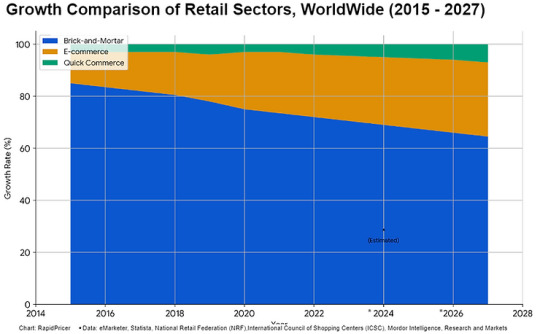
Figure 1: Growth Comparison of Retail Sectors, WorldWide (2015 - 2027)
Global Views on Brick-and-Mortar, E-commerce, and Quick Commerce
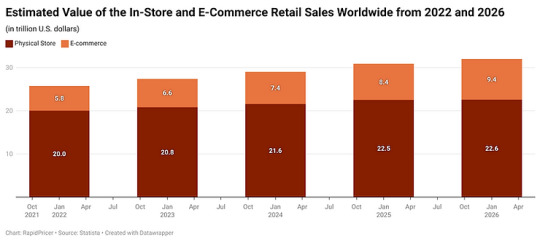
Figure 2: Estimated Value of the In-Store and E-Commerce Retail Sales Worldwide from 2022 and 2026
Remarkably, brick-and-mortar sales growth outpaced e-commerce growth for the first time in 2021 (Forbes, 2022). This demonstrates how much customers still want the in-person purchasing experience. But physical establishments run the risk of slipping behind if they don't adjust to the internet world, including by providing click-and-collect options.
In recent years, e-commerce has grown at an exponential rate. Global e-retail sales are predicted by Statista to reach USD 6.5 trillion by 2023, making up more than 22% of all retail sales. In emerging nations like India, where smartphone usage and internet penetration are rising quickly, this trend is especially noticeable.
Instant Delivery: A Revolution in Retail
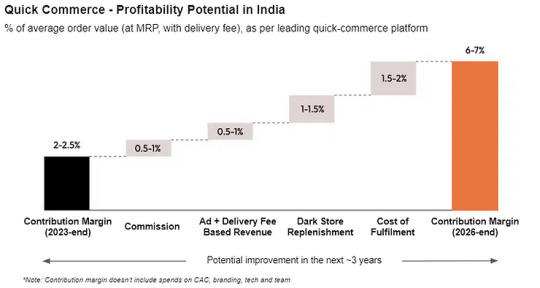
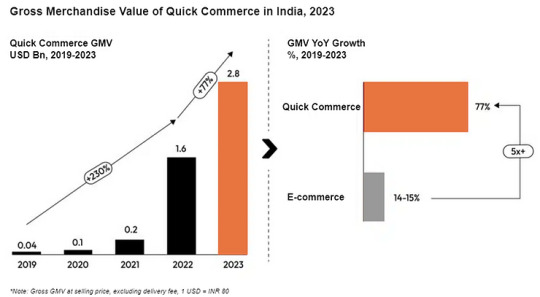
Figure 4: GMV of Quick Commerce in India, 2023 (Source: Redseer) According to Redseer, by 2025, the rapid commerce market in India is expected to grow at a rate of 10-15 times faster than any other market, with a valuation of almost $5.5 billion. This will put it ahead of other markets, including China, in terms of the adoption of quick commerce.
Shifting Logistics and Delivery Investment Dynamics
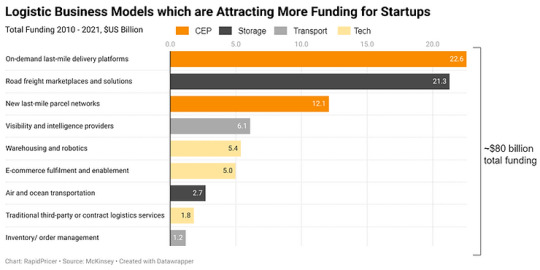
Figure 5: Logistic Business Models Which are Attracting More Funding for Startups
Conclusion:
Businesses need to be competitive as the retail industry changes and adjusts to shifting consumer tastes and technological improvements. Although e-commerce and rapid delivery services have unheard-of development prospects, these business models' viability depends on tackling regional obstacles and making investments in creative solutions. Retailers may prosper in a world that is becoming more digitally and globally integrated by embracing innovation and comprehending the distinctive dynamics of various markets.
About RapidPricer
RapidPricer helps automate pricing and promotions for retailers. The company has capabilities in retail pricing, artificial intelligence and deep learning to compute merchandising actions for real-time execution in a retail environment.
Contact info:
Website: https://www.rapidpricer.com/
LinkedIn: https://www.linkedin.com/company/rapidpricer/
Email: [email protected]
#retailtrends hashtag#ecommerce hashtag#brickandmortar hashtag#instantdelivery hashtag#logistics hashtag#retailinnovation hashtag#retailtech hashtag#digitaltransformation hashtag#consumerbehavior hashtag#globalretail hashtag#marketinsights hashtag#retailindustry hashtag#futureofshopping hashtag#onlineretail hashtag#physicalretail hashtag#supplychain hashtag#techinretail hashtag#retailinvestment hashtag#retailers hashtag#startupinvestment hashtag#retailanalytics hashtag#digitalretail hashtag#shoppingtrends hashtag#retailstrategy hashtag#retailevolution hashtag#economictrends hashtag#retailsolutions hashtag#retailoptimization
0 notes
Text
The Role Of Blockchain And IoT In Retail Supply Chain
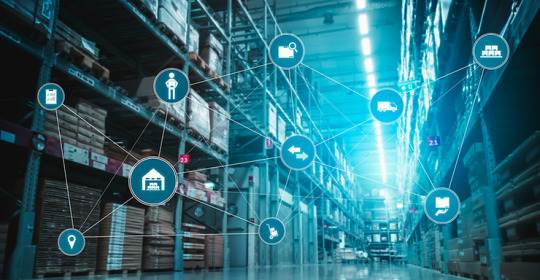
Written By: Gargi Sarma
Introduction:
Within its intricate supply chain, the retail business faces numerous obstacles, such as inefficiencies, a lack of transparency, and difficulties tracing products from manufacturer to consumer. Nevertheless, new technologies that address these persistent problems, such as blockchain and the Internet of Things (IoT), have the potential to completely transform supply chain management.
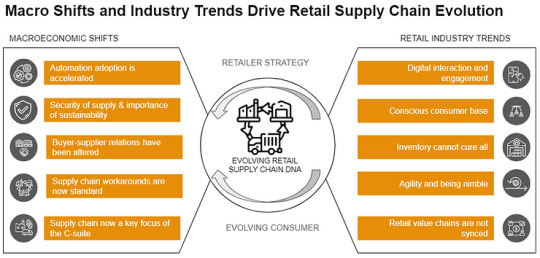
Figure 1: Macro Shifts and Industry Trends Drive Retail Supply Chain Evolution (Source: Deloitte)
Pricing, forecasting, and assortment planning are three major issues in retail supply chain management that might be greatly improved by integrating blockchain and IoT technologies.
Enhancing Pricing Strategies through Blockchain and IoT:
Blockchain Ensures Transparent and Secure Transactions:
Blockchain records transactions in an encrypted, unchangeable ledger spread across multiple nodes, ensuring tamper-proof data and fraud prevention through cryptography.
Blockchain fosters transparency in retail pricing by providing a verifiable record of product interactions, ensuring prices reflect actual market forces, and preventing manipulation.
Retailers can use blockchain to demonstrate the legitimacy and integrity of their pricing schemes, building consumer trust and fostering fair competition in the market.
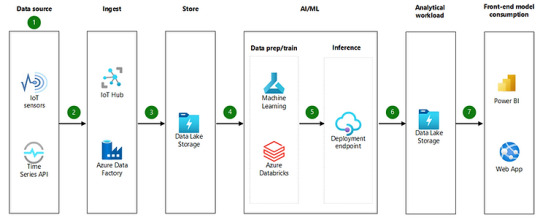
Figure 2: Architecture of IoT Involved in Analytics (Source: Microsoft Azure)
The Internet of Things, or IoT, is a network of devices linked together with sensors and data collection capabilities. IoT devices can be used in physical retail settings and across the supply chain in the retail sector to gather data in real-time on a variety of consumer behavior and market trends.
IoT sensors, for example, may monitor product interactions, track foot traffic in stores, and evaluate purchasing patterns. Retailers may learn a lot about customer preferences, demand swings, and competition dynamics from this data. Retailers may make well-informed decisions in real-time by gaining a thorough understanding of consumer behavior and market trends through the continual collection and analysis of this data.
QR code as an emerging technology:
Blockchain technology combined with QR codes provides a game-changing way to guarantee traceability and transparency across the supply chain, especially when it comes to fresh produce's journey from the farm to the table. Several important criteria can be tracked and confirmed by using blockchain technology in conjunction with QR codes embedded at different stages of the supply chain:
Farm-to-Fresh Traceability: By assigning a unique QR code to a particular batch or lot of produce, customers can scan the code and follow the product's path from the farm to their plate. Customers' trust is increased as a result of the guarantee of authenticity and transparency regarding the produce's origin.
Real-Time Delivery Time Tracking: Blockchain technology allows for real-time tracking of a product's journey, including how long it takes to get from the farm to the customer. Customers can test the freshness of the produce when it arrives by scanning the QR code to get information about the delivery time.
Temperature Monitoring: Data on the state of the temperature during transit can also be stored using QR codes that are integrated with blockchain technology. Temperature variations can be continuously monitored by sensors inside the package, and the blockchain can store this data. By scanning the QR code, customers can confirm the product's temperature history and make sure it was transported and kept in an ideal manner to preserve freshness.
Quality Assurance: The blockchain can be used to track and record several quality metrics, including humidity levels, handling procedures, and storage conditions, in addition to temperature. By scanning the QR code, users may obtain this data, which gives them insights into the quality control procedures followed through the supply chain.
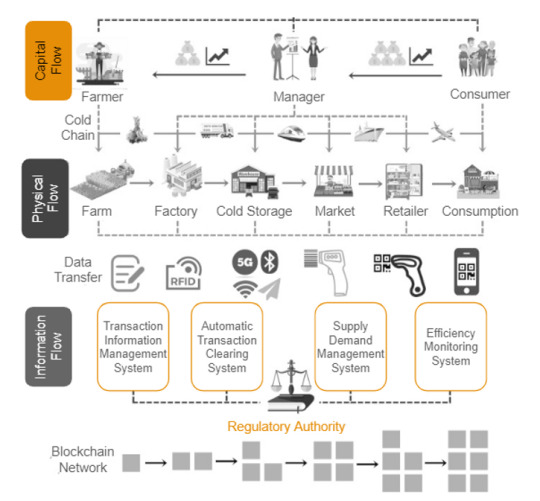
Figure 3: Architecture of IoT Involved in Fresh Produce Block Chain
All things considered, the combination of blockchain technology and QR codes provides a strong way to improve fresh produce's farm-to-table transparency, traceability, and quality control. Customers can increase trust and confidence in the food supply chain by making educated selections based on trustworthy information that they can obtain by scanning QR codes.
Examples of Retail Companies Utilizing Blockchain and IoT for Dynamic Pricing Optimization:
Walmart: The massive retailer uses blockchain technology to improve supply chain traceability and transparency. Walmart gathers data on product demand and inventory levels in real-time by utilizing IoT sensors and data analytics. To optimize pricing strategies and make sure that prices are dynamically updated based on market conditions and consumer preferences, this data is then integrated with blockchain.
Amazon: To collect information on customer behavior and purchase habits, Amazon uses Internet of Things devices like Dash buttons and Echo. Blockchain technology is used with data analysis to allow for dynamic pricing changes on the e-commerce platform. With the help of its pricing algorithms, which track rival and market pricing patterns constantly, Amazon can maximize profits while providing competitive prices to customers in real-time.
Alibaba: To improve confidence and transparency in its online marketplace, the massive Chinese e-commerce company is using blockchain technology. Alibaba tracks product movement and keeps an eye on inventory levels by integrating IoT devices into its supply chain. Alibaba ensures fair and competitive prices for customers by optimizing pricing strategies based on real-time demand signals by fusing blockchain technology with Internet of Things data.
All things considered, these illustrations show how retail businesses are using the convergence of blockchain technology and the IoT to improve pricing tactics, increase transparency, and provide value to consumers in the fast-paced market environment of today.
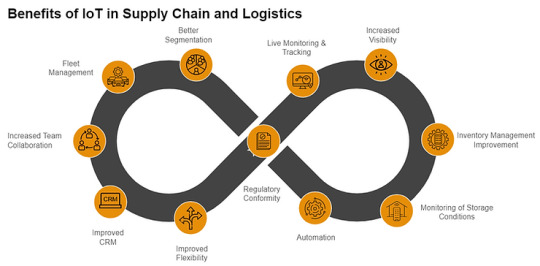
Figure 4: Benefits of IoT in supply chain and logistics (Source: appinventiv)
Exploration of IoT Sensors for Data Collection:
IoT sensors are essential to the change in forecasting because they track inventory movement and customer preferences, among other components of the retail supply chain. These sensors are integrated into distribution hubs, retail locations, and warehouses to continuously monitor product availability, shelf life, and consumer interactions. Retailers may gain a full picture of supply and demand dynamics by using IoT devices to gather real-time data on inventory levels, sales transactions, and consumer behavior.
Blockchain's Contribution to Data Integrity:
Blockchain technology ensures data integrity and reliability, which improves forecasting model accuracy. Data is safely saved and timestamped on the blockchain ledger as it is gathered from IoT devices along the supply chain. This unchangeable record prevents data manipulation and tampering, giving retailers a reliable source of information for forecasting. Retailers can confidently examine past data and forecast future demand trends, inventory requirements, and supply chain optimization plans by utilizing blockchain.
Examples Illustrating Integration of IoT Data with Blockchain:
Walmart: To manage inventory movement and keep an eye on product availability in its shops and warehouses, Walmart uses Internet of Things sensors. Blockchain technology is combined with this real-time data to guarantee supply chain transparency and traceability. Walmart can effectively predict demand for particular products, adjust inventory levels, and reduce stockouts and overstocking by studying this data.
Target: Target uses Internet of Things (IoT) sensors in its retail locations to gather information on customer preferences and purchase trends. Blockchain technology is used in conjunction with this data to establish a safe and trustworthy database for forecasting. Target can forecast demand for seasonal products, identify market trends, and maximize product assortment to satisfy customer expectations by examining trends and patterns in consumer behavior.
Amazon: To collect real-time data on consumer interactions and product sales, Amazon integrates Internet of Things devices like Dash buttons and Echo speakers. For its e-commerce platform, this data is combined with blockchain technology to improve forecasting model accuracy. Amazon can anticipate demand for particular products, modify pricing tactics, and enhance inventory management to effectively satisfy customer demand by examining customer comments, browsing history, and purchase habits.
The retail industry's forecasting is revolutionized by the combination of IoT data and blockchain technology, which gives retailers precise, dependable, and useful insights into supply and demand dynamics. Retail chains may enhance consumer satisfaction, streamline inventory management, and promote long-term growth in the current competitive market environment by capitalizing on this synergy.
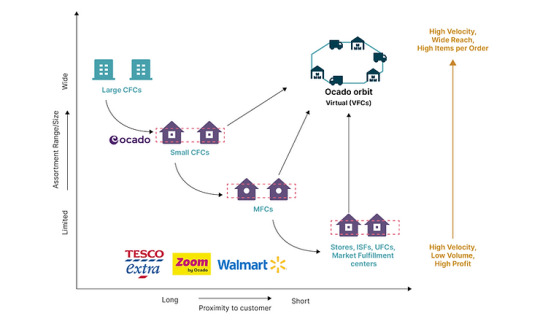
Figure 5: Assortment planning example (Source: thought works)
For the omnichannel network to serve a variety of target segments, it must be optimized. The size and proximity of the client must be taken into consideration while choosing the assortment's breadth and depth. Omnichannel assortment planning must promote corporate objectives including volume, sales, coverage, quantity of orders, and profitability. Figure 4 illustrates how this could seem. The nodes in the omnichannel network are arranged spatially to serve a variety of target markets. The size and proximity of the consumer have a proportionate impact on the assortment's breadth and depth. Results like volume, revenue, coverage, order size, and profitability are all aided by it.
Blockchain's Role in Establishing End-to-End Traceability:
By producing an open and unchangeable record of product transactions, blockchain technology is essential to enabling end-to-end traceability in the supply chain. The blockchain ledger records and verifies every stage of the supply chain, from obtaining raw materials to manufacturing and distribution. This guarantees easy tracing and authentication of the products' source and validity. Blockchain offers an impenetrable and safe platform for recording a product's whole lifespan through decentralized consensus methods and cryptographic technology.
Transparency and Well-Informed Assortment Decisions:
Retailers can make well-informed assortment decisions that are in line with customer values and preferences because of the transparency that Blockchain technology provides. Retailers can create assortments that appeal to their target market by gaining access to verified information on the provenance of products, manufacturing procedures, and sustainability policies. Retailers are also better equipped to adapt to new trends and customer needs thanks to this transparency, which keeps their product offerings current and competitive.
Retail Brands Using Blockchain-Enabled Traceability Examples:
Patagonia: The well-known outdoor clothing company uses blockchain-enabled traceability to guarantee transparent supply chains and ethical sourcing. Patagonia gives customers insight into the lifespan of its products by logging details on the Blockchain, including the source of ingredients, production methods, and environmental impact. Because of this openness, Patagonia is able to make well-informed selection judgments that uphold its core beliefs and give priority to sustainability.
Wine.com: The online wine store Wine.com uses blockchain technology to confirm the provenance and authenticity of the wines it sells. Wine.com gives customers confidence regarding the quality and authenticity of the wines they buy by encrypting information like vineyard location, grape variety, and production techniques into the Blockchain. Because of its transparency, Wine.com can provide a wide range of premium wines from around the globe and create assortments that are customized to each customer's preferences.
Adidas: To guarantee responsibility and transparency in its supply chain, the international sportswear brand incorporates blockchain-enabled traceability. Adidas establishes a verifiable record of product provenance on the blockchain by monitoring the procurement of components like cotton and rubber as well as the production processes of its shoes and clothes. Adidas can make well-informed judgments about product assortment, give ethical sourcing procedures top priority, and gain the trust of customers who respect sustainability and ethical manufacturing thanks to this transparency.
By offering transparency, authenticity, and responsibility across the supply chain, blockchain-enabled traceability enables retailers to simplify assortment planning. Retail brands can use this technology to curate assortments that are in line with consumer preferences, sustainability objectives, and ethical ideals, all of which will increase customer loyalty and confidence.
Conclusion:
In conclusion, retail supply chain management is undergoing a revolutionary change as a result of the combination of blockchain and IoT technology. These breakthroughs present previously unheard-of chances to tackle enduring issues and transform crucial areas like assortment strategy, forecasting, and pricing.
Blockchain promotes confidence and integrity throughout the supply chain by guaranteeing safe and transparent transactions. Dynamic decision-making is made possible by the real-time data collection capabilities of IoT, which offer priceless insights into market trends and consumer behavior.
Retailers that are utilizing IoT data integration and blockchain-enabled traceability are leading the way in innovation, optimizing operations, improving consumer experiences, and fostering long-term growth. These technologies will have a profound effect on the retail sector as they develop further, changing how companies run and engage with customers in a world that is becoming more digitally and globally connected.
About RapidPricer
RapidPricer helps automate pricing and promotions for retailers. The company has capabilities in retail pricing, artificial intelligence and deep learning to compute merchandising actions for real-time execution in a retail environment.
Contact info:
Website: https://www.rapidpricer.com/
LinkedIn: https://www.linkedin.com/company/rapidpricer/
Email: [email protected]
#retailtech hashtag#innovation hashtag#supplychaintransformation hashtag#retailindustry hashtag#technologytrends hashtag#transparency hashtag#dataintegration hashtag#digitaltransformation hashtag#supplychainoptimization hashtag#customerexperience hashtag#businessstrategy hashtag#retailinnovation hashtag#iotinretail hashtag#blockchaintechnology hashtag#supplychainvisibility hashtag#retailanalytics hashtag#digitalretail hashtag#futureofretail hashtag#smartretail hashtag#ecommerce hashtag#sustainableretail hashtag#retailers hashtag#customerengagement hashtag#retailinsights hashtag#iotIntegration hashtag#blockchaininretail
0 notes
Text
Challenges with Pricing for the High-End Fashion Industry in the US
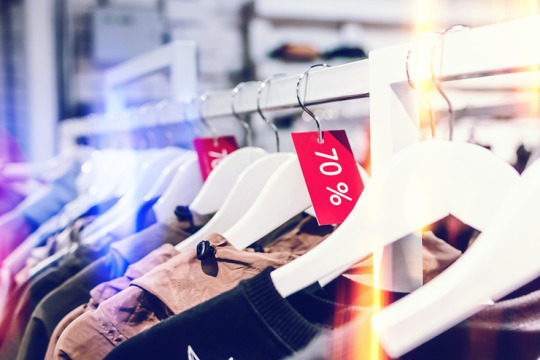
Written By: Gargi Sarma Introduction:
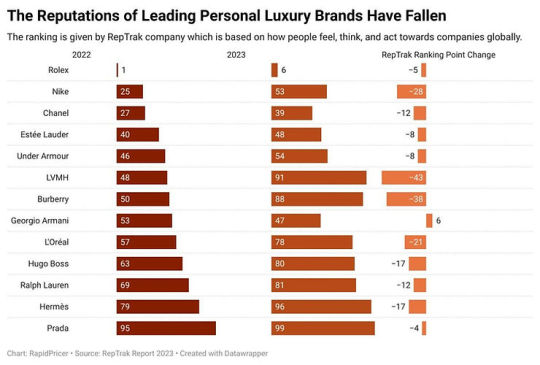
Figure 1: Ranking of Personal Luxury Brands (2022 & 2023)
From Figure 1, we can observe that the year 2023 saw the second consecutive year with a fall in the aggregate RepTrak reputation score. It fell for the first time since 2018, falling from 74.9 in 2021 to 74.2 in 2022. Additionally, the average dropped to 73.2 in 2023.
Recognizing the Dynamics of the Market:

Figure 2: BAC US Card Spending Data Growth For Luxury Fashion, YoY
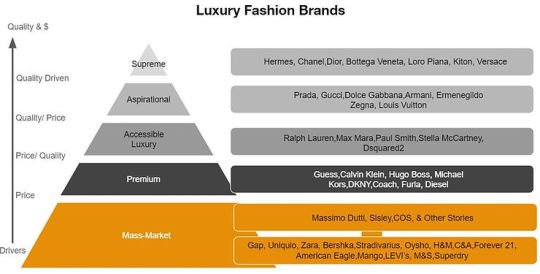
Figure 3: Luxury Fashion Brands - The Fashion Pyramid (Source: TRF / Strategy Consulting, 2020)
Production Costs: Superior materials, expert craftsmanship, and cutting-edge design methods are frequently substantially invested in by luxury firms. Chanel's renowned tweed jackets, for instance, are expensive because they require fine fabrics and meticulous handwork.
Positioning and Brand Image: To support their high prices, luxury brands need to carefully manage their image. To ensure that its items keep their prized status, Hermes, for example, limits manufacturing and distribution to maintain its exclusivity.
Trends and Seasons: The difficulty for high-end fashion manufacturers is striking a balance between trendy looks and classic appeal. Balenciaga's Triple S sneakers, for instance, sold out quickly at first because of their strong demand, but sustaining their premium cost needed rigorous control of supply and demand dynamics.
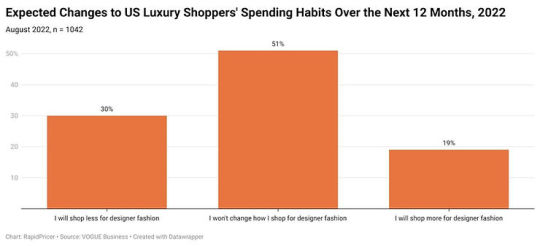
Figure 4: Expected Changes to US Luxury Shoppers' Spending Habits Over the Next 12 Months, 2022
Challenges Faced by High-End Fashion Brands:
High-end fashion pricing in the US faces several challenges due to various factors, including consumer perception, market competition, production costs, and economic conditions. Here are some challenges, along with examples:
Perceived Value vs. Production Cost: High-end fashion brands often struggle to justify their high prices to consumers who may not fully understand the production process and quality of materials. Balancing the perceived value with the actual production cost is crucial. Example: A luxury brand may use high-quality materials and skilled craftsmanship to produce a handbag, driving up the production cost. However, consumers may question the high price if they perceive similar-looking handbags from other brands as being of comparable quality.
Market Saturation and Competition: The high-end fashion market in the US is saturated with numerous brands vying for consumer attention. Intense competition can lead to pricing pressures as brands attempt to differentiate themselves while maintaining profitability. Example: A new high-end sneaker brand enters the market with innovative designs and premium materials. However, established luxury sneaker brands already dominate the market, making it challenging for the new entrant to command premium prices without a strong brand reputation.
Brand Image and Prestige: High-end fashion brands rely heavily on their brand image and prestige to justify premium pricing. Maintaining exclusivity while reaching a broader consumer base presents a delicate balancing act for these brands. Example: Chanel, known for its iconic handbags and timeless designs, carefully controls its distribution channels to maintain exclusivity. However, the brand also faces pressure to appeal to younger consumers without diluting its luxury image.
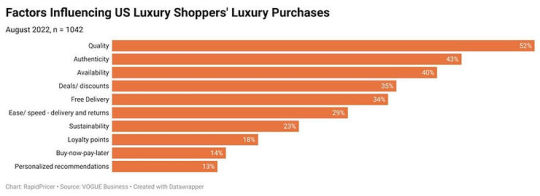
Figure 5: Factors Influencing US Luxury Shoppers' Luxury Purchases, 2022
Economic Factors and Consumer Behavior: Economic downturns and fluctuations in consumer spending can significantly impact high-end fashion pricing. Brands must navigate shifting consumer preferences and adapt their pricing strategies accordingly. Example: During a recession, consumers may prioritize essential purchases over luxury items, leading to decreased demand for high-end fashion products. In response, luxury brands may offer discounts or adjust their pricing to appeal to budget-conscious consumers.
Counterfeiting and Brand Dilution: Counterfeit products pose a significant threat to high-end fashion brands, undermining their exclusivity and brand integrity. Lower-priced knockoffs can dilute the perceived value of authentic products and impact pricing strategies. Example: Louis Vuitton faces ongoing challenges with counterfeit handbags flooding the market. Despite efforts to combat counterfeiting, the availability of cheap knockoffs can make consumers hesitant to pay premium prices for genuine Louis Vuitton products.


Figure 7: Luxury Brands' Online Popularity Change from 2022 to 2023
Trends in Fashion System Highlights:
The following developing issues are highlighted in McKinsey's 2024 report and will be high on the agendas of the fashion system's leaders.
Generative AI: More application cases are appearing in the sector following 2023, the year that generative AI (gen AI) made its breakthrough. Fashion players will need to look past automation to realize profit, and investigate how Gen AI may improve the job of human creatives.
Fast fashion's manipulation: The rivalry in the fast-fashion industry is expected to intensify. Rivals, spearheaded by Shein and Temu, are introducing novel strategies concerning cost, client satisfaction, and velocity. Navigating the regulatory agenda while adjusting to changing customer demands may be the difference between disruptors and incumbents in terms of success.
Every eye is on the brand: It is anticipated that brand marketing will regain prominence when the fashion sector successfully moves away from performance marketing. As marketers rewrite playbooks to emphasize long-term brand creation, brands may profit from developing emotional ties with consumers.
Sustainability is paramount: The days of self-regulation in the fashion business are coming to an end. New regulations will have a big impact on consumers and fashion industry operators everywhere. Manufacturers and brands might think about updating their business models to reflect the upcoming changes.
Bullwhip retaliates: The "bullwhip effect," which causes order volatility to echo unpredictably through supply chains, has been brought about by changes in customer demand. As brands and retailers prioritize openness and strategic collaborations, suppliers are expected to experience more pressure.
Conclusion:
The shifting production costs, fiercer competition, and changing consumer tastes provide serious pricing issues for the US high-end fashion market. Industry participants need to use adaptable pricing strategies that strike a balance between exclusivity and accessibility while staying aware of changing market conditions to successfully negotiate these complications.
About RapidPricer
RapidPricer helps automate pricing and promotions for retailers. The company has capabilities in retail pricing, artificial intelligence and deep learning to compute merchandising actions for real-time execution in a retail environment.
Contact info:
Website: https://www.rapidpricer.com/
LinkedIn: https://www.linkedin.com/company/rapidpricer/
Email: [email protected]
#luxuryfashion hashtag#pricingstrategy hashtag#fashionindustry hashtag#consumerbehavior hashtag#brandimage hashtag#economicfactors hashtag#competitiveenvironment hashtag#retailpricing hashtag#fashiontrends hashtag#brandmarketing hashtag#sustainability hashtag#aiinfashion hashtag#fastfashion hashtag#retailtech hashtag#fashionretail hashtag#exclusivity hashtag#customerexperience hashtag#supplychain hashtag#retailautomation hashtag#fashionmarketing hashtag#brandbuilding hashtag#retailinnovation hashtag#fashioninsights hashtag#fashionbusiness hashtag#retailtechnology hashtag#luxurybrands hashtag#retailtechsolutions hashtag#fashionretailers hashtag#fashionanalytics
0 notes
Text
Unveiling Global Price Differences for Grocery Retailing

Written By: Gargi Sarma
In today's worldwide market, pricing comparisons between nations are crucial for retailers as well as customers. Retailers may strategically place their items in different areas and optimize their pricing strategies to maximize profitability and remain competitive by having a thorough awareness of price discrepancies. However, consumers who compare costs across borders are better able to make informed judgments about what to buy and receive the most value for their money, whether they choose to shop locally or look into foreign options.
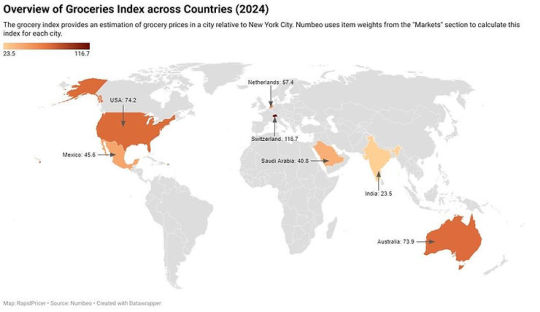
Figure 1: Overview of Groceries Index across Countries (2024)
To give businesses and consumers alike a thorough grasp of worldwide price discrepancies, this article seeks to offer insightful information about the importance of comparing costs across national borders. The topic for retailers will examine how to use market insights to optimize pricing strategies and boost competitiveness, delving into the strategic implications of price differentials.
Understanding Price Disparities:
Retailers must comprehend national pricing differences to manage their operations and pricing strategies in foreign markets. These differences are the result of several factors, each of which has a distinct impact on the retail environment:
Currency Exchange Rates: Changes in exchange rates affect retail prices and import expenses. To reduce currency-related risks, retailers need to make frequent price adjustments.
Tariffs and Taxes: International retail prices are impacted by both government taxes and tariffs. Retailers who want to maintain competitive pricing must be aware of and abide by local tax legislation.
Living Expenses: Differences in living expenses have an impact on retail prices and purchasing power. Retailers modify their pricing tactics to take local cost of living considerations into account.
Supply Chain Dynamics: Retail pricing is impacted by the complexity and efficiency of the supply chain. Retailers streamline their supply networks to cut expenses and guarantee on-time delivery.
Regulatory Disparities: Differences in regulations impact retail pricing and raise the cost of compliance. When entering new areas, retailers must manage the complexities of regulations.
The Impact of Globalization: Through convergence and divergence, globalization affects retail prices. Retailers modify their tactics to take advantage of economies of scale and serve a variety of markets.
Methodology for Comparing Prices:
Several approaches are employed when comparing pricing between nations to guarantee accurate and insightful comparisons. Gaining dependable insights into price differences requires a grasp of the strengths and limits of each methodology. Below is an explanation of the various pricing comparison methodologies:
Parity of Purchasing Power (PPP): By comparing the costs of goods and services across countries and adjusting exchange rates to equalize prices when stated in a common currency like the US dollar, PPP theory analyzes monetary values.
Price Index (e.g., Consumer Price Index): Indices such as the CPI monitor variations in the average price of a basket of goods and services over time, indicating trends in either deflation or inflation as well as shifts in the purchasing power of a country.
The Basket of Goods Method: This method provides information on relative affordability and market competitiveness by comparing the costs of a chosen set of goods and services across international borders. Retailers frequently use it to evaluate pricing tactics and make comparisons with rival businesses.
Case Studies and Examples:
Comparison of Prices for Selected Goods and Services Across Different Countries:
Food and Groceries
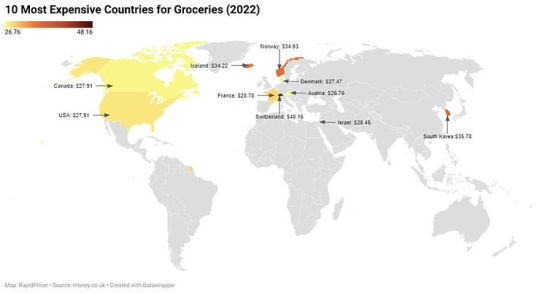
Figure 2: 10 Most Expensive Countries For Groceries (2022)
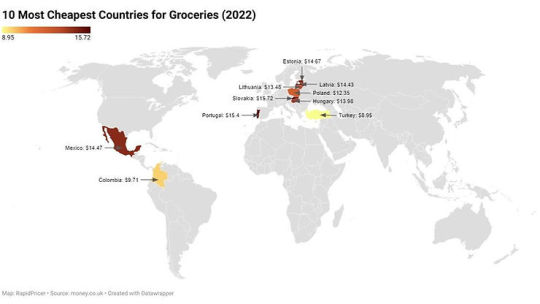
Figure 3: 10 Most Cheapest Countries For Groceries (2022)
USA: Brand, store type and location are some of the variables that affect food prices in the USA. When compared to other industrialized nations, the average cost of groceries in the USA is reasonable.
India: Because of its big agricultural sector and cheaper production costs, India typically has lower food prices than other nations. Prices, however, might differ greatly between rural and urban locations.
Mexico: A lot of reasonably priced food options are available in Mexico, especially for locally manufactured goods. Costs may be comparatively lower in Mexico than in other nations, which draws travellers on a tight budget.
Netherlands: Due to factors including high labor expenses, stringent regulations, and import tariffs, food prices in the Netherlands are often higher than in several other European countries. But there are other reasonably priced solutions out there, particularly in supermarkets.
Switzerland: The country is renowned for having a high cost of living, which includes comparatively high food prices. Switzerland has higher grocery costs due to several factors, including a small amount of arable land, hefty import taxes, and a strong currency.
Dubai: The cost of food varies in Dubai based on several variables, including store type, location, and the proportion of domestically and imported goods. Due to import duties, some products may be pricey, but others—especially locally-grown produce—may be reasonably priced.
Singapore: Land scarcity, high labor costs, and reliance on imports are some of the factors influencing Singapore's food prices. Although meal costs in Singapore are often higher than in its neighbors, there are some reasonably priced options, especially at hawker centers.
Australia: Due to reasons including geographic remoteness, high labor expenses, and stringent restrictions, food prices in Australia might be relatively high when compared to some other countries. But there are other reasonably priced solutions out there, particularly in local markets and supermarkets.

Figure 4: Price Level By Country
Healthcare services
USA: The United States of America has some of the highest healthcare expenditures in the world, primarily due to high administrative costs, costly medical procedures, and pharmaceutical pricing.
India: Compared to wealthy nations, healthcare services in India are typically more economical, with lower consultation, hospital, and prescription prices. India has a high rate of medical tourism because of its affordable healthcare alternatives.
Mexico: In comparison to the United States, Mexico provides reasonably priced healthcare services, with lower consultation fees, hospitalization charges, and drug pricing. Mexico is seeing an increase in medical tourism as well, especially for elective treatments.
Netherlands: With a sophisticated healthcare system and universal health coverage, healthcare prices in the Netherlands are reasonable when compared to those in several other European nations. Nonetheless, the cost of private healthcare services can often be high.
Switzerland: Due to variables including pricey medical equipment, high-quality healthcare infrastructure, and high salaries for medical professionals, Switzerland has some of the highest healthcare expenditures in the world.
Dubai: Depending on a number of variables, including the facility type, medical expertise, and insurance coverage, the cost of healthcare services in Dubai varies greatly. In comparison to Western nations, certain services might be more reasonably priced, while others might be more costly.
Singapore: In comparison to Western nations, Singapore provides excellent healthcare services at reasonably affordable prices. Residents can afford healthcare more easily because of government insurance programs and healthcare subsidies.
Australia: With a combination of public and private healthcare choices, healthcare prices in Australia are low when compared to some other wealthy nations. The government's Medicare program lowers individuals' out-of-pocket costs by offering subsidies for necessary medical services.
Regional Variances and Trends:
With an emphasis on retail pricing, the following examines regional price disparities and new developments in worldwide price patterns:


Figure 6: Average Cost of Meal For Two in 2020 (Source: Numbeo.com)
Asia-Pacific: Because of the region's varied economic development levels, disparities in infrastructure, and import/export expenses, there are notable pricing fluctuations in this area. For comparable commodities, industrialized economies like South Korea and Japan typically charge more than developing economies like Vietnam and India.
Europe: Because of economic unity brought forth by the European Union, price fluctuations within Europe are less than those in Asia-Pacific. Prices nevertheless vary due to disparities in taxation and living levels. Prices in Western European nations are often higher than those in Eastern European nations.
New Developments in International Price Trends:
Influence of e-commerce: Pricing competition and transparency are being increased by online retailers, which is reducing regional pricing differences for some products. Prices can still vary, though, due to things like local taxes and delivery expenses.
Impact of COVID-19: The pandemic generated transitory price changes and supply chain disruptions for a variety of items, especially those that had production issues or were strongly dependent on imports. While some prices have leveled off, persistent interruptions may have long-term effects on others.
Strategies for Retailers to Leverage Price Differences:
Cross-Border Shopping:
Retailers can leverage price differences by sourcing products from countries where production costs or taxes are lower.
Establishing partnerships with suppliers in different countries allows retailers to access a wider range of products at competitive prices.
By offering imported goods at lower prices compared to domestic alternatives, retailers can attract price-conscious consumers and gain a competitive edge in the market.
2. Online Shopping:
Online shopping enables retailers to reach customers beyond geographical boundaries, allowing them to tap into markets with favorable price differentials.
Setting up an e-commerce platform allows retailers to offer products at competitive prices to international customers, leveraging lower production costs or tax advantages in certain regions.
Dynamic pricing algorithms can be employed to adjust prices based on real-time market conditions, optimizing profitability while remaining competitive in the global marketplace.
3. Market Localization:
Retailers can tailor pricing strategies to local market conditions, taking into account factors such as consumer purchasing power, competitive landscape, and regulatory environment.
Offering region-specific promotions, discounts, and pricing strategies helps retailers appeal to local preferences and capture market share effectively.
Localization efforts extend beyond pricing to include product assortment, marketing campaigns, and customer service, fostering a deeper connection with target audiences.
4. Strategic Alliances and Partnerships:
Collaborating with local businesses or distributors in target markets allows retailers to leverage their expertise and networks to navigate regulatory complexities and distribution channels.
Strategic alliances enable retailers to access market insights, infrastructure, and resources that may otherwise be inaccessible or costly to develop independently.
By forming partnerships with trusted local partners, retailers can establish a stronger presence in international markets and leverage price differences to their advantage.
5. Data-Driven Pricing Optimization:
Utilizing data analytics and predictive modeling enables retailers to identify pricing opportunities and optimize pricing strategies based on market demand, competitor pricing, and consumer behavior.
Implementing dynamic pricing algorithms allows retailers to adjust prices in real-time, responding to changes in market conditions, inventory levels, and competitive dynamics.
By leveraging data-driven insights, retailers can maximize profitability while remaining responsive to price differentials and market trends.
Retailers can leverage price differences through cross-border shopping, online shopping, market localization, strategic alliances, and data-driven pricing optimization. By adopting these strategies, retailers can enhance competitiveness, expand market reach, and capitalize on opportunities presented by global price differentials.
Conclusion:
Retailers must compare prices across national borders to maximize profitability, improve competitiveness, and optimize their pricing strategies in the global economy. Retailers can find ways to take advantage of cheaper production costs, attractive exchange rates, and market-specific factors by carefully analyzing price differentials. Retailers may effectively navigate international marketplaces and take advantage of price gaps by using strategies including data-driven pricing optimization, market localization, cross-border shopping, online shopping, and strategic alliances. Retailers may improve their market position, increase their client base, and promote sustainable growth in an increasingly interconnected world by comprehending and taking advantage of worldwide price disparities.
About RapidPricer
RapidPricer helps automate pricing and promotions for retailers. The company has capabilities in retail pricing, artificial intelligence and deep learning to compute merchandising actions for real-time execution in a retail environment.
Contact info:
Website: https://www.rapidpricer.com/
LinkedIn: https://www.linkedin.com/company/rapidpricer/
Email: [email protected]
#globalcommerce hashtag#pricecomparison hashtag#retailstrategy hashtag#consumerinsights hashtag#markettrends hashtag#crossbordershopping hashtag#globalization hashtag#retailoptimization hashtag#pricedifferentials hashtag#marketcompetitiveness hashtag#internationaltrade hashtag#economicanalysis hashtag#retailindustry hashtag#supplychainmanagement hashtag#dataanalytics hashtag#pricingstrategy hashtag#marketlocalization hashtag#strategicalliances hashtag#ecommerce hashtag#retailinnovation hashtag#businessgrowth hashtag#marketexpansion hashtag#globaleconomy hashtag#retailtech hashtag#retailinsights hashtag#groceryretail hashtag#businessdevelopment hashtag#retailers hashtag#consumers
0 notes
Text
Enhancing Customer Loyalty with AI-Driven Pricing and Rewards
Written By: Gargi Sarma

Introduction
Attracting clients is only half the fight in the dynamic and cutthroat Mexican industry. The real challenge is holding them and cultivating genuine brand loyalty. Data points to a developing trend: Mexican consumers are becoming more brand-savvy and looking for companies that provide value, customization, and a sincere feeling of connection. In these areas, traditional loyalty programs frequently fall short, but artificial intelligence (AI) is bringing in a new age in this regard.

Figure 1: Market Size of Artificial Intelligence in Mexico (2020 - 2030)
Long-term success in Mexico's retail sector depends on cultivating consumer loyalty in the face of intense competition. To accomplish this, retailers must be able to provide customized incentives and pricing schemes, which are made possible by AI-driven pricing and rewards. Mexican businesses may better understand their consumers' tastes and behaviors by utilizing advanced algorithms and data analytics. This helps them design promotions and rewards programs that are tailored to the interests of specific customers. In the end, this individualized strategy results in improved consumer loyalty and repeat business by improving the overall shopping experience and fortifying the relationship between customers and businesses.
Understanding AI-Driven Pricing

Figure 2: Retail Price Optimization (Source: tezo)

Figure 3: Benefits of AI in the Retail Industry (Source: Netsolution)
Increased pricing accuracy: ompared to conventional techniques, AI-driven algorithms are more accurate in identifying pricing patterns by analyzing large volumes of data.
Real-time responsiveness: AI gives merchants the ability to dynamically modify prices in reaction to shifting market dynamics, maintaining competitiveness, and optimizing profits.
Personalization: AI enables merchants to adjust price plans according to the interests of specific customers, improving the shopping experience and encouraging patronage.
Enhanced efficiency: Retailers save time and money when pricing choices are automated by AI, eliminating the need for manual involvement.
Competitive edge: Retailers may maintain an advantage over rivals by using AI to price their products more competitively and react to market developments more quickly.
Case studies of successful implementation
OXXO
Implementation: To increase consumer loyalty, OXXO, a well-known convenience store chain in Mexico, used AI-driven pricing techniques.
Approach: OXXO used dynamic pricing algorithms to modify prices in response to seasonality, competition, and demand.
Results: By providing competitive prices and tailored promotions, the use of AI-driven pricing increased consumer satisfaction and loyalty. OXXO experienced a rise in client retention rates and recurrent purchases.
Impact: OXXO maintained a devoted customer base and improved its competitive position in the market by utilizing AI for pricing.
Liverpool
Implementation: To increase consumer loyalty, Liverpool, a well-known department store in Mexico, implemented AI-driven pricing tactics.
Approach: Liverpool adopted a predictive analytics approach to examine client information and spot pricing patterns. They put into practice customized pricing plans depending on the tastes and purchasing habits of each customer.
Results: Increasing consumer engagement and loyalty was the outcome of using AI-driven pricing. Liverpool had an increase in average order value and improved levels of customer satisfaction.
Impact: Liverpool was able to give its consumers a better tailored shopping experience by utilizing AI for pricing, which strengthened customer loyalty and raised revenue.

Figure 4: An Example of Personalized AI Recommendation for Retailers (Source: ZS) For Mexican retailers, personalization is vital to their loyalty programs because it enables them to give clients customized experiences. Retailers are able to provide rewards that personally connect with each client by getting to know their preferences, buying habits, and past purchases. This improves the entire shopping experience and fortifies the relationship between the customer and the retailer. Personalized awards can make companies stand out and encourage a loyal following of customers in a country as diverse as Mexico, where consumer preferences are very variable.

Figure 5: Application of AI to Enhance Customer Experience (Source: SproutSocial)
Artificial intelligence plays a crucial role in the Mexican industry by analyzing client data, which allows for individualized rewards and improves loyalty programs. Large volumes of consumer data, including browsing patterns, purchase histories, and demographic data, can be analyzed by AI-powered algorithms to provide insightful results. Retailers can segment their customer base and provide rewards based on their understanding of customers' interests and behavior patterns. AI facilitates real-time analysis as well, allowing merchants to modify their rewards programs in response to shifting consumer preferences and market trends. AI-driven consumer data analysis enables merchants to design more compelling and successful loyalty programs that increase customer pleasure and loyalty in Mexico's cutthroat retail environment.
Examples of personalized rewards programs
Soriana Club: Soriana Club is a customized rewards program offered by Soriana, one of the biggest supermarket chains in Mexico. Members receive tailored discounts and offers according to their interests and buying behaviors.
OXXO Más: Based on members' purchase histories and preferences, the OXXO Más loyalty program offers members personalized incentives and discounts. OXXO is a prominent convenience store brand in Mexico.
Cinépolis Club: Based on members' viewing patterns and preferences, the Cinépolis Club loyalty program offers members personalized perks, like free tickets and concession savings. Cinépolis is a well-known movie theatre chain in Mexico.
Liverpool One Card: Liverpool, a well-known department store in Mexico, has a loyalty program called Liverpool One Card, which gives members customized advantages and rewards depending on their preferences and past purchases.
Strategies for Enhancing Customer Engagement
Utilizing AI for targeted promotions
AI technology is being used by Mexican retailers to offer customer-resonant, customized marketing. Through the examination of consumer information such as past purchases, online browsing patterns, and demographics, merchants can find ways to provide tailored discounts and rewards. The best time, channel, and messaging for promotions may be found using AI-driven algorithms, guaranteeing maximum engagement and conversion. Retailers in Mexico benefit from this focused approach, which raises consumer happiness and boosts marketing campaigns' efficacy while increasing sales and loyalty.

Figure 6: Implementing Gamification Elements in Rewards Program (Source: White Label Loyalty)
A smart strategy for Mexican retailers looking to boost consumer engagement is to incorporate gamification elements into their incentive programs. By adding elements like badges, challenges, and points, retailers may improve the engagement and customer happiness of their loyalty programs. As a result of their frequent engagement, customers are more inclined to take part in and make additional purchases from gamified initiatives. By introducing gamified rewards programs, retailers may also obtain valuable customer data and insights that help them to further personalize the shopping experience and cultivate long-term loyalty.
Creating seamless omnichannel experiences
Mexican merchants should develop seamless omnichannel experiences that let customers engage with the brand at several touchpoints to improve customer engagement. Retailers may offer customers a seamless shopping experience by connecting their online and offline channels. This enables customers to browse, purchase, and engage with the brand without interruption across various channels. In the end, this promotes engagement and loyalty by guaranteeing consistency and ease for customers, irrespective of how they choose to interact with the business.
Future Trends and Opportunities
Emerging Technologies Shaping the Future of Loyalty Programs
AI-powered customization: It enables tailored pricing, rewards, and product suggestions by analyzing large datasets to comprehend specific client preferences. This improves perceived value and creates a closer bond.
Real-time insights-driven dynamic pricing: AI examines the pricing tactics of competitors, market trends, and individual customers to recommend the best possible prices. This can optimize earnings while providing each customer with the appropriate pricing.
Targeted promotions with predictive analytics: AI forecasts future purchases and, at the appropriate moment, sends out tailored offers, discounts, or prizes to encourage consumer interaction.
Interactive experiences and gamification: AI incorporates gamification components into loyalty programs, including leaderboards, badges, and points, to boost consumer happiness and engagement.
Omnichannel loyalty programs: AI combines consumer information from offline and online sources to provide a streamlined, customized experience at every point of contact.
Opportunities for retailers to differentiate themselves
Provide value-based incentives: Go beyond points and provide customized incentives based on user preferences, such as first access to sales, special discounts, or unique experiences.
Put your attention on developing strong emotional bonds: Use AI to personalize communications, foresee client needs, and proactively resolve problems to build loyalty and trust.
Accept openness and moral behavior: Make that AI-powered reward and pricing schemes are equitable, transparent, and don't target any particular client base differently.
Give privacy and data security first priority: To earn customers' trust and confidence, put in place strong data security procedures and disclose to them precisely how client data is utilized.
Conclusion:
The key to retaining customers in the future is to use AI to build individualized experiences that strengthen bonds and add value. Mexican companies have a special chance to stand out in a crowded market by implementing AI-driven pricing and rewards. To win over customers' trust and sustain their loyalty over time, it is imperative to give ethical behavior, openness, and data security a top priority. Retailers who strategically apply these tactics will be well-positioned to forge lasting relationships with their customers and achieve sustainable development in the dynamic retail environment, even as AI technology continues to advance.
About RapidPricer
RapidPricer helps automate pricing and promotions for retailers. The company has capabilities in retail pricing, artificial intelligence and deep learning to compute merchandising actions for real-time execution in a retail environment.
Contact info:
Website: https://www.rapidpricer.com/
LinkedIn: https://www.linkedin.com/company/rapidpricer/
Email: [email protected]
#ai hashtag#retail hashtag#customerloyalty hashtag#mexico hashtag#dynamicpricing hashtag#rewardsprograms hashtag#personalization hashtag#dataanalytics hashtag#artificialintelligence hashtag#retailtech hashtag#marketingstrategy hashtag#customerengagement hashtag#omnichannelexperience hashtag#gamification hashtag#futuretrends hashtag#predictiveanalytics hashtag#ecommerce hashtag#retailinnovation hashtag#businessstrategy hashtag#digitaltransformation hashtag#marketinsights hashtag#brandloyalty hashtag#sustainablegrowth hashtag#ethicalai hashtag#datasecurity hashtag#customerexperience hashtag#markettrends hashtag#retailers
0 notes
Text
Dynamic Assortment based on Seasons and Demand

Written By: Gargi Sarma
Mexico is distinguishing itself as one of the major markets through persistent development and gradual but consistent expansion in numerous areas. One industry that could outpace Mexico's typical projected national growth is the retail and consumer sector. By 2028, the retail market in Mexico is anticipated to expand at a CAGR of 5%. A mix of sociodemographic and economic changes, products, and commercial strategies to lure Mexican customers will drive this. More than any other industry, Mexico's retail and consumer sectors represent the prospects arising from the country's economic dualism. Alongside the resilient traditional 'changarros' and adapted ideas like OXXO and Farmacias Similares, there is a steady growth and development of modern format retail outlets and global franchises like Walmart and Starbucks.
In Mexico, COVID-19 has had a major impact on consumer shopping habits. Companies increased their efforts on digital platforms in response to the COVID-19 epidemic. These investments included creating a more user-friendly website, introducing direct-to-consumer operations, and forming partnerships with last-mile delivery providers.
The retail fashion sector in Mexico is thriving and changing quickly, driven by a wide range of consumer preferences and buying habits. Retailers can find a wide range of prospects in the Mexican market, from vibrant metropolises to charming small communities. A significant obstacle, though, is there among all of this dynamism: seasonal variations in consumer demand. Mexico's vast territory, diverse climate, and rich cultural traditions create a compelling case for optimizing assortments based on seasonal and location-specific factors. Here's why:
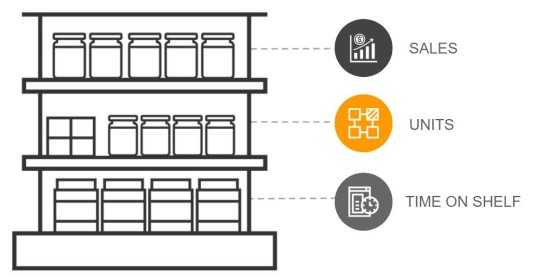
Figure 1: Importance of Assortment Planning
Increased Sales and Profits:
Meeting local demand: Offering products relevant to the local climate, holidays, and cultural preferences ensures you cater to customer needs and avoid stocking unwanted inventory. Imagine stocking winter jackets in Cancun or beach gear in Monterrey during winter.
Seasonal trends: Capitalizing on seasonal events like Christmas, back-to-school, or Cinco de Mayo with targeted product offerings can significantly boost sales.
Differentiation from competitors: Understanding local nuances allows you to stand out by offering unique products not available elsewhere, attracting and retaining customers.
Reduced Costs and Improved Efficiency:
Optimized inventory management: Matching your assortment to local demand helps reduce overstock and deadstock, lowering storage and disposal costs.
Improved supplier relationships: Working with local suppliers for seasonal products aligns with sustainability goals and potentially reduces transportation costs.
Efficient marketing: Tailoring marketing campaigns to specific locations and seasons ensures you reach the right audience with relevant messaging, maximizing campaign effectiveness.
Challenges of Seasonal Fluctuations:
Inventory management: Predicting demand accurately and avoiding overstock or stockouts is challenging, especially with sudden weather changes.
Price optimization: Balancing profits with competitive pricing during different seasons requires careful planning and adjustments.
Marketing and promotions: Tailoring campaigns to each season and reaching the right audience while managing advertising budgets effectively is crucial.
Staffing: Hiring and training additional staff during peak seasons can be costly and demanding.
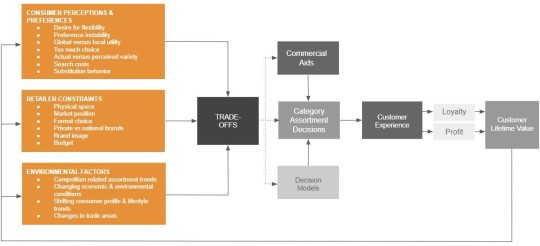
Figure 2: Challenges in Assortment Planning (Source: Why is Assortment Planning so Difficult for Retailers? A Framework and Research Agenda, Murali et al., 2009)
Geographical Considerations in Mexico:
Mexico's vastness and diverse geography paint a complex picture for retailers. Understanding how climate, terrain, and cultural traditions influence consumer behavior across regions is crucial for tailoring assortments and maximizing success.
Diverse Landscape:
Northern regions: Arid climates with hot summers and mild winters dominate. Think Chihuahua, Sonora, and Baja California.
Central highlands: Temperate climate with warm, dry summers and cool winters. Puebla, Tlaxcala, and Mexico City fall under this category.
Southern regions: Tropical climates with high humidity and hot temperatures year-round. Chiapas, Quintana Roo, and Oaxaca exemplify this zone.
Coastal areas: Varied climates depending on location. Pacific coasts tend to be drier, while Gulf coasts experience more humidity.
Impact on Preferences:
Clothing: Northern regions demand lighter clothing year-round, while southern regions require breathable fabrics suitable for humid conditions. Winter gear becomes relevant in the highlands.
Outdoor activities: Northern regions favor desert sports and hiking, while coastal areas see demand for water sports and beach gear. The highlands might see higher sales of camping equipment.
Home decor: Southern regions might opt for lighter furniture and natural materials, while colder areas might prefer heavier fabrics and heating solutions.
Food: Local ingredients and dishes vary greatly across regions. Northern cuisine tends to feature meat and beans, while southern cuisine leans towards seafood and tropical fruits.
Data-driven Approach to Assortment Planning:
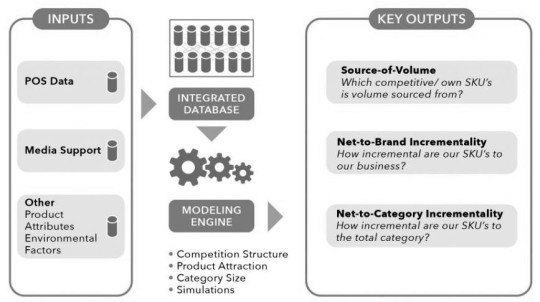
Figure 3: Data-driven Approach to Assortment Planning (Source: Analytic Edge)
These days, modern retail assortment planning is data-driven, using sales data to estimate demand and gain insight into customer preferences and historical performance. By disclosing rival tactics and market trends, market research enhances this strategy and enables merchants to modify assortments appropriately. Customization of product offers is made possible by the deeper understanding of customer behavior and preferences provided by consumer insights obtained through focus groups and surveys. By offering precise demand projections based on historical sales data and industry trends, machine learning and predictive analytics further improve assortment decisions. Retailers earn higher sales as a result of this inventory optimization.
Implementing Seasonal and Location-Based Assortments
The implementation of location- and season-based assortments in retail necessitates a methodical approach that takes seasonal shifts in consumer demand and geographic variations into account. Retailers can customize assortments to meet local demand and seasonal components by examining market trends, regional preferences, and historical sales data. Data analytics and inventory management systems enable strategies for optimizing inventory levels and SKU distribution across sites. Efficient cooperation between suppliers and partners guarantees the prompt supply of seasonal merchandise, and partnerships with local designers provide distinctive, locally-inspired items to assortments, making them more appealing to local clients.
Technology Solutions for Assortment Optimization:

Figure 4: Strategies to Optimize Product Assortment
Technology solutions are essential for retail assortment optimization because they provide state-of-the-art tools and platforms that improve decision-making and expedite assortment planning. Retailers can take advantage of a range of software tools and platforms, including category management software and assortment optimization platforms, that are designed to match their unique requirements. Because they can provide data-driven insights and predictive modeling skills, advanced analytics, artificial intelligence, and machine learning are essential for enhancing assortment strategies. Careful planning and execution are necessary for the successful integration of digital solutions into retail operations. To guarantee maximum benefits, special requirements must be assessed, comprehensive training must be given, and maintenance must continue.
Examples of Mexican Retailers Using Dynamic Assortment:
Costco - Costco's dynamic assortment strategy keeps up with seasonal and cultural trends, such as Mexican holidays and festivals, and offers a variety of products to attract customers.
Walmart - Walmart's Mexican stores, such as Sam's Club and Walmart Supercenter, feature dynamic assortments of products that change based on the seasons and customer demand.
The Home Depot - The Home Depot's Mexican stores offer a wide range of products for DIY enthusiasts and contractors, including seasonal items such as Christmas lights and Easter decorations.
Target - Target's Mexican stores, such as Target Hidalgo and El Paso.
Conclusion:
In summary, changing customer tastes, macroeconomic conditions, and technological breakthroughs will propel the retail industry in Mexico, which is expected to experience rapid expansion. Retailers may successfully manage seasonal swings, regional variances, and shifting market dynamics to optimize assortments and boost profitability by using data-driven strategies. The secret to success in this dynamic and exciting market will be to leverage technology solutions, strategic relationships, and a thorough awareness of local situations.
About RapidPricer
RapidPricer helps automate pricing and promotions for retailers. The company has capabilities in retail pricing, artificial intelligence and deep learning to compute merchandising actions for real-time execution in a retail environment.
Contact info:
Website: https://www.rapidpricer.com/
LinkedIn: https://www.linkedin.com/company/rapidpricer/
Email: [email protected]
#retailmexico hashtag#consumersector hashtag#retailtrends hashtag#mexicanmarket hashtag#assortmentplanning hashtag#retailstrategy hashtag#seasonaldemand hashtag#geographicalvariations hashtag#retailtech hashtag#dataanalytics hashtag#inventorymanagement hashtag#retailinnovation hashtag#customerpreferences hashtag#marketinsights hashtag#retailinsights hashtag#retailers hashtag#dynamicassortment hashtag#retailautomation hashtag#mexicanretailers hashtag#retailexpansion hashtag#economicgrowth hashtag#RetailChallenges hashtag#marketdynamics hashtag#seasonaltrends hashtag#locationbasedassortments hashtag#retailtechnology hashtag#artificialintelligence hashtag#machinelearning hashtag#retailoptimization
1 note
·
View note
Text
Dynamic Shifts in Retail Formats: Meeting Growing Demands Over Time in Mexico
Written By: Gargi Sarma
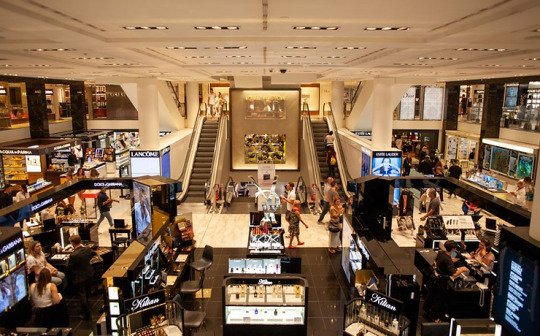
Introduction:
Mexico has a thriving and varied retail scene that includes both classic and modern formats to meet the wide range of needs of the nation's customers. Mexican consumers have access to a diverse range of shopping experiences, ranging from vibrant markets and corner stores to expansive supermarkets and virtual marketplaces.

Figure 1: Market Share of Retail Models in Mexico (2022)
The changing nature of consumer needs is a notable feature of Mexico's retail industry. The shifting demographics, urbanization, and technological improvements driving the economy also drive changes in Mexican consumers' preferences and behaviors. Customers expect quality, variety, price, and convenience, which forces businesses to constantly innovate and adjust in response to these changing needs.
This article delves into the intriguing transformations taking place in the Mexican retail scene, specifically emphasizing the adjustments made to shop structures. We examine the shift from conventional storefronts to more contemporary spaces, examining the forces behind this change and its effects on shops and customers. We can obtain important insights into the changing retail dynamics influencing the Mexican market by looking at the dynamic interaction between customer needs and store formats.
Overview of Retail Formats in Mexico:
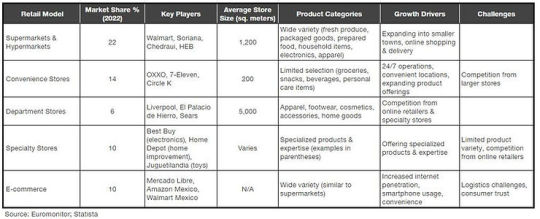
Figure 2: Modern Retail Models in Mexico
Growing Demands Driving Changes:
Key trends:
Rising disposable income: Increased spending power fuels demand for diverse and higher-quality products.
Urbanization: Growing urban population seeks convenience and a wider product range, driving demand for modern formats.
Technological adoption: Increased internet & smartphone usage influences online shopping and omnichannel experiences.
Changing values: Growing awareness of sustainability and health, impacting product choices and shopping preferences.
Experience: Desire for personalized, convenient, and engaging shopping experiences.
Retail Format Shifts:
Driving factors:
Urbanization: Demand for smaller, accessible formats like convenience stores and proximity retail.
Rising income: Growth of supermarkets, hypermarkets, and specialty stores offering wider product variety.
Globalization: Entry of international retailers and brands influencing format trends and competition.
E-commerce boom: Rapid growth of online shopping platforms like Mercado Libre and Amazon Mexico.
Changing consumer preferences: Shift towards convenience, experience, and omnichannel shopping journeys.
Case Studies:
OXXO: Convenience store chain adapting to changing demands by expanding product offerings, introducing digital services, and partnering with delivery platforms.
HEB supermarkets: Targeting premium grocery segment with a focus on fresh produce, prepared meals, and online ordering.
Liverpool department store: Launching omnichannel initiatives, integrating online and offline shopping experiences.
Mercado Libre e-commerce platform: Expanding physical presence with pickup points and partnering with traditional retailers.
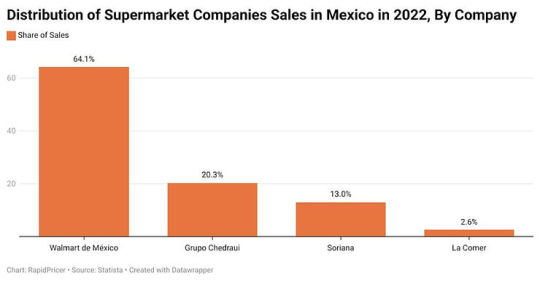
Figure 3: Distribution of Supermarket Companies Sales in Mexico in 2022, By Company
In 2022, the Mexican business of Walmart de México y Centroamérica accounted for 64.1% of total supermarket sales. The business made 813.06 billion Mexican pesos in net revenues in 2022 (Figure 4).
Evolution Over Time:

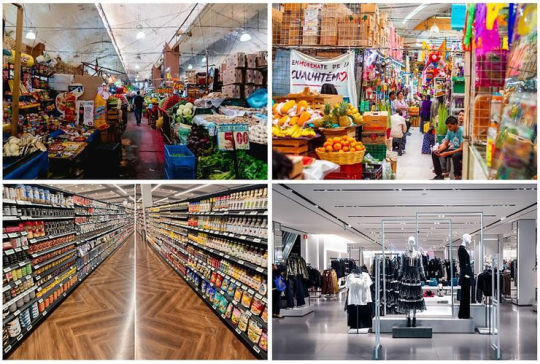
Figure 5: Comparison of Traditional and Modern Retail Landscapes in Mexico
Adaptation and Innovation:
Key adaptation strategies:
Omnichannel integration: Connecting online and offline experiences through click-and-collect, mobile apps, and personalized promotions.
Enhanced convenience: Expanding delivery options, self-checkout systems, and mobile payment solutions.
Data-driven insights: Utilizing customer data to personalize offers, optimize inventory, and predict trends.
Focus on experience: Creating engaging shopping environments, offering loyalty programs, and hosting events.
Sustainable practices: Implementing eco-friendly packaging, reducing waste, and sourcing responsibly.
Case Studies:
OXXO convenience stores: Partnering with delivery platforms, expanding payment options, and offering localized product selections.
Walmart Mexico: Launching "Super Willys" smaller format stores, investing in mobile payments, and expanding online grocery delivery.
Liverpool department store: Integrating virtual fitting rooms, offering personalized styling consultations, and partnering with local designers.
Farmacias del Ahorro pharmacy chain: Utilizing AI to optimize logistics and inventory management, and offering telemedicine services.
Challenges and Opportunities:
Challenges: Mexican retailers encounter infrastructure constraints, such as insufficient transportation and logistics systems, which may impede the effectiveness of their supply chains. Retailers face additional challenges in navigating the market from regulatory constraints such as complicated licensing procedures and taxation policies.

Figure 6: Retail Market in Mexico, 2022 - 2023 (Source: Technavio)
According to Technavio, between 2021 and 2026, the retail market in Mexico has the potential to increase by USD 9.72 billion.
Conclusion:
Technological developments, shifting consumer preferences, and socioeconomic transformations are all causing dynamic changes in Mexico's retail environment. The retail industry in Mexico shows a wide range of structures meeting the different needs of customers, from conventional markets and family-owned stores to contemporary supermarkets and e-commerce platforms. Retailers can innovate and adapt despite ongoing problems like infrastructure restrictions and regulatory obstacles. Retailers can overcome these obstacles and take advantage of Mexico's expanding market potential by utilizing technological advancements, adopting omnichannel strategies, and placing a high priority on the consumer. Proactive adjustment and calculated innovation will be essential for the retail sector to prosper in this changing and cutthroat environment as it continues to change.
About RapidPricer
RapidPricer helps automate pricing and promotions for retailers. The company has capabilities in retail pricing, artificial intelligence, and deep learning to compute merchandising actions for real-time execution in a retail environment.
Contact info:
Website: https://www.rapidpricer.com/
LinkedIn: https://www.linkedin.com/company/rapidpricer/
Email: [email protected]
#retailtransformation hashtag#mexicanretail hashtag#retailinnovation hashtag#consumertrends hashtag#urbanizationimpact hashtag#technologicaladvancements hashtag#omnichannelexperience hashtag#economicgrowth hashtag#sustainableretail hashtag#customerexperience hashtag#markettrends hashtag#retailevolution hashtag#convenienceshopping hashtag#supermarkettrends hashtag#ecommerceboom hashtag#digitaltransformation hashtag#dataanalytics hashtag#customerinsights hashtag#supplychainchallenges hashtag#regulatoryenvironment hashtag#infrastructureconstraints hashtag#marketopportunities hashtag#retailtech hashtag#dynamicShifts hashtag#adaptationstrategies hashtag#businessinnovation hashtag#retailgrowth hashtag#mexicaneconomy hashtag#marketexpansion hashtag#retailsolutions
0 notes
Text
Evolution of Retail Consumers in Mexico
Written By: Gargi Sarma
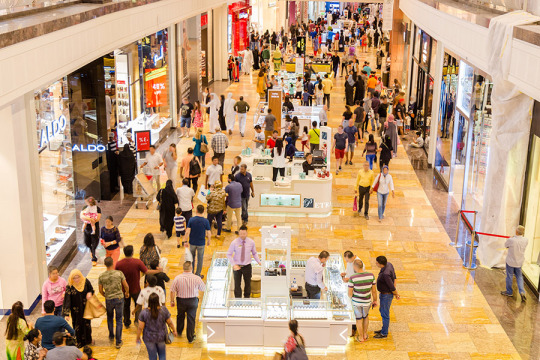
Success in today's dynamic retail environment depends critically on recognizing and meeting customers' changing demands and preferences. This is particularly true in Mexico's dynamic market, where urbanization, shifting demographics, and changes in consumer behavior are transforming the retail industry.
The growing need for convenience is one of the major themes influencing consumer behavior in Mexico. Convenience is given top priority when making purchases by modern consumers due to their hectic schedules and high standards. Time is becoming more and more of a limited resource, which is driven by several causes such as urbanization, longer working hours, and the development of dual-income households.

Figure 1: Online Acceleration in Mexico, 2022 (Source: McKinsey & Company)
In contrast to pre-pandemic levels, online sales of books and consumer electronics rose significantly in Mexico, and despite flat global demand, a wide range of consumer products showed a shift in sales to e-commerce platforms as a result of the pandemic (Figure 1).
Market Dynamics:
The Mexican convenience store market is expected to grow at a CAGR of 5.4% from 2022 to 2027. This growth is being driven by several factors, including the increasing urbanization of the Mexican population, the rising disposable incomes of Mexican consumers, and the growing popularity of convenience shopping.
The new Mexican consumer is younger, more tech-savvy, and more demanding than previous generations. They are looking for convenient shopping experiences that are tailored to their needs and preferences.
Retailers need to adopt new business models to cater to the new Mexican consumer. This includes offering a wider variety of products and services, providing more convenient shopping options, and using technology to personalize the shopping experience.
Knowing Consumer Values: Two Mexicos, One Growing Middle Class
Mexico's Duality: A clear image of economic and social inequality is painted by the idea of two Mexicos: one established and formal, and the other less developed and informal. A growing middle class made up of customers from both sides, who individually cling to their values while looking for goods and services that speak to them, is the unifying factor within this complex terrain.
Recognizing the Principles: Although the story of "Two Mexicos" depicts general economic realities, it's important to keep in mind that customers within each category are not monolithic groups. The middle class has a wide range of complex and varied values and goals.
From Mexico's Developed States:
Aspiration for modernity: Customers look for cutting-edge technology and fashionable, well-known brands worldwide.
Appreciate quality and experience: They place a high priority on upscale goods, practicality, and individualized care.
Awareness of one's well-being and health: Eco-friendly, sustainable, and organic products are popular.
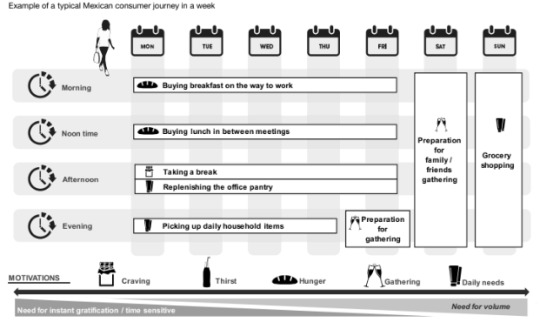
Figure 2: Example of A Typical Mexican Consumer Journey in a Week (Source: PwC)
From Mexico informally:
Value for money: Practicality and affordability should be prioritized, along with budget consciousness.;
Community and trust are important Strong relationships are formed between known stores and local brands.
Entrepreneurial spirit: Do-it-yourself projects and resourcefulness are highly valued.
Filling the Void: Comprehending these distinctions in values is imperative for companies targeting the expanding middle class. Effective tactics will not only copy models from "Mexico," but instead provide a range of goods and services: Appeal to premium and cost-conscious markets.
Adopt omnichannel tactics: For ease of use and accessibility, integrate physical and online experiences.
Bring new ideas to the local market: Adjust international patterns to suit local tastes and circumstances.
Establish community and trust: Join forces with nearby companies and participate in neighborhood projects.
The New Mexican Consumer:
Tech-savvy and mobile: This group is comfortable using online tools for shopping, research, and payments. They expect seamless omnichannel experiences.
Time-pressed: Juggling work, family, and social commitments, they value convenience and speed. They're more likely to make smaller, frequent purchases than large, infrequent ones.
Value-conscious: They seek quality products at affordable prices. Private-label brands and value packs can be appealing.
Digitally connected: They rely on social media and online reviews for information and recommendations. Building a strong online presence is crucial.
Mexican Consumers Look to E-commerce for Better Prices:
Mexican consumers, particularly younger generations, are increasingly turning to e-commerce for their shopping needs, driven by the allure of better prices. This trend is fueled by several factors, including rising inflation, growing internet access, and the convenience of mobile shopping. Platforms like Mercado Libre and Amazon are attracting new users seeking deals and wider product selection compared to traditional brick-and-mortar stores. While brand loyalty remains important, price sensitivity is driving the shift, with savvy shoppers comparing prices across platforms before making a purchase. This trend presents both challenges and opportunities for businesses, requiring them to adapt their online strategies to offer competitive pricing, seamless buying experiences, and robust logistics networks to meet the expectations of the evolving Mexican consumer.

Figure 3: Top Reasons For Buying Food and Household Supplies Online, Mexico (2023)
In Figure 3, according to the McKinsey Survey, the results between the pre-COVID-19 pandemic and early 2023, it was revealed that although it is no longer the primary means of purchase for Mexican consumers as it was during the pandemic, online shopping nevertheless accounts for a larger portion of purchases than it did before the outbreak: 17 percent of respondents say they shop online for most or all of their purchases, up from 15 percent of prepandemic respondents. Customers claim that the main reason they shop online is the price: they can locate more affordable goods, take advantage of larger discounts, and quickly compare costs across various merchants. Online purchasing is convenient for them as well. However, they do have some reservations about online shopping. These reservations stem from the potential for defective or damaged goods to arrive, mismatches between what is advertised online and what is received, and expensive delivery or shipping costs.

Figure 4: Share of Respondents Reporting That They Buy Products Online Most of the Time Or Always, By Category, Mexico (2023)
According to the McKinsey Survey (Figure 4), the results between the pre-COVID-19 pandemic and early 2023, it was revealed that the mentioned categories saw the largest movement away from traditional brick-and-mortar stores and toward online shopping: cosmetics, consumer electronics, and toys and infant supplies. These tendencies have a resemblance to e-commerce patterns observed in developed markets.
Going Beyond Division:
It's critical to keep in mind that distinctions between the "two Mexicos" are becoming more hazy. As consumers become more knowledgeable and connected, hybrid values—which combine old sensibilities with modern aspirations—become more prevalent.
Through identification of this dynamic and comprehension of the varied values held by the emerging middle class, companies can seize enormous prospects inside the Mexican market.
Prioritizing ease in their goods and strategies is crucial for merchants hoping to win over the attention and allegiance of the new Mexican consumer. The following are some crucial tactics that retailers should use:
Optimized Store Formats: To improve customer convenience, retailers can rethink their store layouts. To make shopping more efficient, this involves placing products in strategic locations, having clear signage, and having a simple navigation system. Convenience can be further improved by providing options like click-and-collect or in-store pickup for online orders.
E-commerce and Delivery Services: E-commerce is expanding quickly in Mexico as a result of the country's rising smartphone and internet connectivity rates. By making investments in reliable online platforms and effective delivery services, retailers may profit from this trend. Options for same-day or next-day delivery can greatly increase convenience for customers who would rather purchase from home.
Localized Assortments: By ensuring that customers can locate the items they need without having to search far, localized product assortments can increase convenience by taking into account regional preferences. In order to appeal to various customer segments, merchants provide a variety of payment choices as part of their specialized approach.
Technology Integration: You may improve convenience and expedite the shopping process by utilizing technology, such as digital loyalty programs, self-checkout kiosks, and mobile apps. Mobile apps, for example, can save users time and effort by offering tailored suggestions, instant inventory updates, and easy payment processes.
Convenient Payment Solutions: Offering digital wallets, installment plans, and contactless payment choices can streamline the payment process, reducing friction at the point of sale and improving customer convenience. Additionally, loyalty programs that offer discounts for regular purchases might encourage recurring business.
Emphasis on Accessibility: Providing a really easy shopping experience requires ensuring accessibility for all customers, especially those with special needs or disabilities. This entails taking into account things like wheelchair accessibility, unambiguous signage, and assistance services to let clients successfully explore the store.
Conclusion:
In summary, convenience is now a need for merchants hoping to succeed in Mexico's cutthroat market rather than merely a nice-to-have. Through the implementation of tactics that cater to the needs of the New Mexican Consumer and a focus on convenience, businesses may foster customer loyalty, increase customer happiness, and ultimately thrive in the dynamic retail industry.
About RapidPricer
RapidPricer helps automate pricing and promotions for retailers. The company has capabilities in retail pricing, artificial intelligence and deep learning to compute merchandising actions for real-time execution in a retail environment.
Contact info:
Website: https://www.rapidpricer.com/
LinkedIn: https://www.linkedin.com/company/rapidpricer/
Email: [email protected]
#retailevolution hashtag#mexicanconsumers hashtag#convenienceshopping hashtag#ecommercetrends hashtag#techsavvyconsumers hashtag#urbanizationimpact hashtag#middleclassgrowth hashtag#consumerbehavior hashtag#omnichannelretail hashtag#mexicanmarket hashtag#digitaltransformation hashtag#onlineshopping hashtag#customerexperience hashtag#retailindustry hashtag#pricesensitivity hashtag#brandloyalty hashtag#convenientpaymentoptions hashtag#localizedassortments hashtag#mobileshopping hashtag#retailinnovation hashtag#marketdynamics hashtag#mexicaneconomy hashtag#digitalloyaltyprograms#hashtag#ConvenientPaymentMethods#CustomerSatisfaction#RetailTechnology#EconomicTrends#CustomerConvenience#MexicanRetail
0 notes
Text
Artificial Intelligence Adoption in Retail is Real!

Written By: Gargi Sarma
The retail industry is undergoing significant upheaval, with artificial intelligence (AI) leading in this disruptive wave. The once-speculative murmurs about AI's potential have become a loud reality, changing the retail industry from the ground up. Introducing artificial intelligence (AI) into retail operations is becoming a necessary current force rather than a far-off promise as companies fight to stay ahead in a period of unheard-of innovation. Join us as we explore how artificial intelligence has assiduously become part of the retail industry, revealing previously undiscovered levels of productivity, customization, and first-rate customer service. The retail era of artificial intelligence (AI) is here to stay and is already changing the way that people purchase in the future.
Market Overview: Artificial Intelligence in Retail
The adaptation of AI in retail is indeed a booming trend, and the market reflects this with impressive growth and vast potential. Here's a breakdown:
Market Size and Growth:

Figure 1: Artificial Intelligence (AI) in Retail Market Size, 2023 to 2032 (USD Billion)
The retail artificial intelligence (AI) market was valued at USD 8.41 billion in 2022, and by 2032, it is expected to have grown to over USD 45.74 billion, with a compound annual growth rate (CAGR) of 18.45% (Figure 1).
This rapid growth signifies the increasing adoption of AI by retailers across various segments.
Key Drivers:
Personalized shopping experiences: AI personalizes recommendations, offers virtual consultations, and enhances customer engagement.
Demand forecasting and inventory management: AI improves demand prediction, optimizes inventory levels, and reduces out-of-stock situations.
Enhanced customer service: AI-powered chatbots and virtual assistants answer questions, handle simple inquiries, and improve customer satisfaction.
Operational efficiency: AI robots automate tasks, analyze data for insights, and optimize operations to boost efficiency.
Regional Landscape:
North America: Currently holds the largest market share (40% in 2022) due to early adoption and high technology penetration. (Source: Fortune Business Insights)
Asia Pacific: This rapidly growing market is driven by factors like increasing internet users and smartphone adoption.
Europe: Strong presence of major tech players and focus on innovation propelling the market growth.
The Rise of the Retail Revolutionaries:
Gone are the days of static, one-size-fits-all shopping. AI is empowering retailers to adapt and evolve in exciting ways:

Figure 2: Benefits of Artificial Intelligence (AI) for Retail Business Worldwide, 2022
Personalized Experiences: Imagine walking into a store and being greeted by name, with recommendations tailored to your past purchases and browsing habits. AI-powered chatbots and product suggestions make this a reality, enhancing customer engagement and satisfaction.
Inventory Optimization: Say goodbye to stockouts and empty shelves. AI algorithms analyze sales data, predict demand fluctuations, and optimize inventory levels, ensuring you find what you need, when you need it.
Dynamic Pricing: AI can adjust prices in real-time based on market trends, competitor analysis, and even individual customer profiles. This ensures competitive pricing strategies while maximizing profits.
Enhanced Security: From facial recognition for fraud prevention to AI-powered cameras that detect suspicious activity, retail spaces are becoming safer and more secure.
Streamlined Operations: AI automates repetitive tasks like product categorization, data entry, and even checkout processes, freeing up staff for more valuable customer interactions.
Adapting to the Future:
The impact of AI extends beyond individual stores, influencing the entire retail ecosystem:
Supply Chain Management: AI optimizes logistics and transportation networks, ensuring efficient delivery and minimizing waste.
Targeted Marketing: By analyzing customer data, AI creates highly targeted marketing campaigns, reaching the right audience with the right message at the right time.
Virtual Shopping Experiences: From immersive VR showrooms to AR product visualization tools, AI is blurring the lines between online and offline shopping, creating engaging and interactive experiences.
Artificial Intelligence Adaptation in Retail: Real Examples
Artificial intelligence (AI) is rapidly transforming the retail landscape, weaving itself into the fabric of our everyday shopping experiences. From hyper-personalized recommendations to automated checkout and optimized logistics, AI is no longer a novelty, but a powerful tool driving real change. Let's delve into some concrete examples of AI adaptation in retail, backed by data to showcase its impact:

Figure 3: AI Use Cases in Consumer Goods and Retail Industry Worldwide, 2020
Approximately 50% of participants from the retail and consumer goods sectors believe that implementing AI can enhance customer service. This implies that, in instances where it is unable to help, an AI solution can take over augmented interactions to respond to queries from customers and direct them to the appropriate agent. Furthermore, according to 47% of respondents, AI can significantly improve inventory management by assisting in the efficient management of expenses and buyer needs. In other words, artificial intelligence (AI) keeps track of supply and demand numbers at physical stores and online to make sure they are in line (Figure 3).
Personalized Shopping:
Amazon: The retail giant leverages AI to analyze billions of data points, including past purchases, browsing history, and even social media activity, to recommend products with uncanny accuracy. This personalization drives customer engagement and loyalty, with studies showing a 35% increase in conversion rates.

Figure 4: Amazon’s AI features (Source: AWS)
Sephora: Sephora's Beauty Insider program uses AI-powered chatbots to offer personalized beauty consultations through its "Beauty IQ" tool. This virtual assistant analyzes customer preferences and skin concerns, recommending customized product regimens. The program boasts a 25% increase in customer engagement and a 10% rise in average order value.

Figure 5: Beauty IQ tool by Sephora (Source: Sephora)
Inventory Optimization:
Walmart: The retail behemoth utilizes AI to predict demand fluctuations across its vast network of stores. This intelligent system analyzes weather patterns, local events, and even social media trends to ensure shelves are always stocked with the right products at the right time. The result? A 10% reduction in out-of-stock occurrences and a 5% increase in sales.

Figure 6: Sam's Club, in partnership with Brain Corp, has deployed 600 autonomous floor scrubbers with inventory scan towers in Walmart stores (Source: Walmart)
Target: Target employs AI-powered "smart shelves" equipped with sensors that track inventory levels in real-time. These shelves automatically trigger restocking orders, minimizing stockouts and optimizing floor space utilization. This system has led to a 2% increase in sales and a 4% reduction in labor costs.
Dynamic Pricing:
Best Buy: The electronics giant uses AI algorithms to adjust prices on select products in real-time based on market trends, competitor analysis, and even individual customer profiles. This dynamic pricing strategy allows Best Buy to remain competitive while maximizing profits. Data suggests a 3% increase in revenue and a 2% boost in customer satisfaction.
Amazon: Similar to Best Buy, Amazon implements dynamic pricing on millions of products, often adjusting prices multiple times a day based on demand and competition. This strategy has contributed significantly to Amazon's dominance in the online retail market.
Enhanced Security:
Home Depot: This home improvement giant utilizes AI-powered security cameras with facial recognition capabilities. These cameras can identify known shoplifters and alert store security, deterring theft and improving overall security. Studies show a 20% reduction in shoplifting incidents at Home Depot stores equipped with these cameras.
7-Eleven: Convenience store chain 7-Eleven employs AI-powered cameras that analyze customer behavior patterns to detect suspicious activity, such as loitering or vandalism. This proactive approach improves store safety and reduces the risk of crime.
Streamlined Operations:
Kroger: The grocery giant uses AI-powered robots to automate tasks like scanning shelves, checking inventory, and cleaning spills. These robots free up human employees to focus on customer service and other high-value tasks, increasing overall efficiency and productivity. Kroger estimates a 20% reduction in labor costs and a 5% improvement in operational efficiency

Figure 7: AI robots at Kroger (Source: Forbes)
Amazon Go: This innovative store concept boasts cashierless shopping powered by AI and computer vision. Shoppers simply grab their desired items and walk out, with sensors automatically tracking what they take and charging their accounts accordingly. This frictionless experience reduces checkout wait times and increases customer satisfaction.
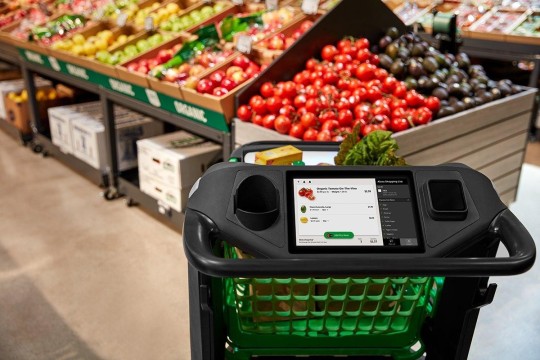
Figure 8: Amazon Go Grocery Store (Source: Amazon Go)
Beyond Individual Stores:
The impact of AI in retail extends beyond the storefront, influencing the entire ecosystem:
Supply Chain Management: AI optimizes logistics and transportation networks for companies like UPS and FedEx, ensuring efficient delivery and minimizing waste. This intelligent system has led to a 10% reduction in delivery times and a 5% decrease in transportation costs.
Targeted Marketing: Retailers like Nike and Adidas leverage AI to create highly targeted marketing campaigns based on customer demographics, purchase history, and online behavior. This data-driven approach delivers relevant advertisements, leading to a 15% increase in click-through rates and a 10% rise in conversion rates.
Virtual Shopping Experiences: Companies like Lowe's and Wayfair utilize AR technology powered by AI to allow customers to virtually visualize products in their homes before purchase. This immersive experience increases customer confidence and satisfaction, resulting in a 20% boost in online conversion rates.
Conclusion: The future of retail is adaptable
The examples here only scratch the surface of AI's revolutionary potential in retail. AI is changing how we purchase and how shops operate, from faster processes to tailored experiences. There is no denying the advantages of implementing AI, even though issues like data privacy and employment displacement must be carefully considered.
One thing is certain as AI develops and becomes more advanced: retail will always need to be flexible. The best-positioned retailers to prosper in this changing environment will be those who deliberately and ethically integrate AI. They will develop individualized customer experiences that make them happy, streamline processes for maximum effectiveness, and construct a flexible and long-lasting company plan.
About RapidPricer
RapidPricer helps automate pricing and promotions for retailers. The company has capabilities in retail pricing, artificial intelligence and deep learning to compute merchandising actions for real-time execution in a retail environment.
Contact info:
Website: https://www.rapidpricer.com/
LinkedIn: https://www.linkedin.com/company/rapidpricer/
Email: [email protected]
#aiinretail hashtag#retailrevolution hashtag#artificialintelligence hashtag#retailtech hashtag#customerexperience hashtag#inventoryoptimization hashtag#dynamicpricing hashtag#retailinnovation hashtag#supplychainmanagement hashtag#virtualshopping hashtag#personalization hashtag#operationalefficiency hashtag#datadrivenretail hashtag#futureofretail hashtag#retailtransformation
0 notes